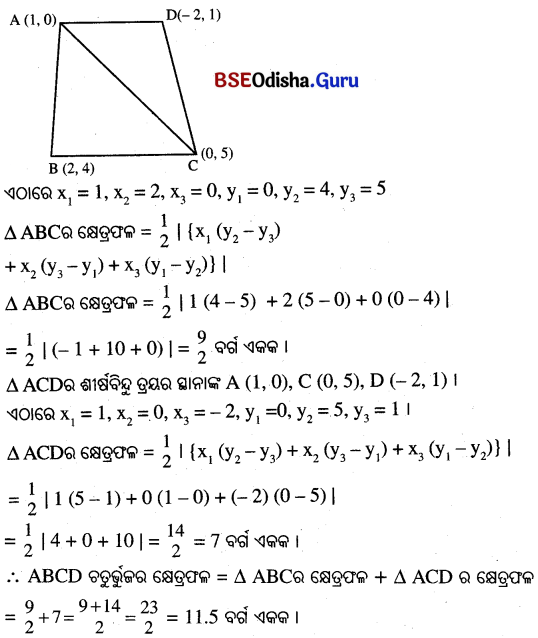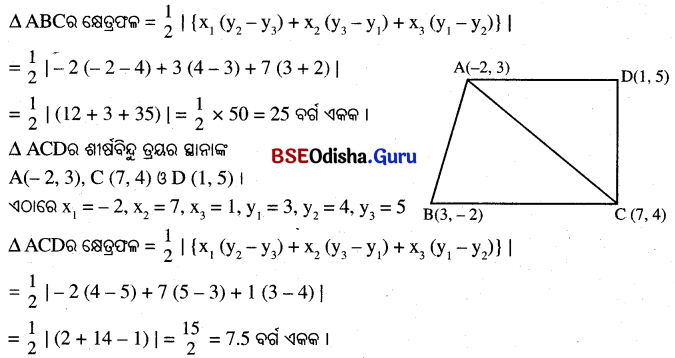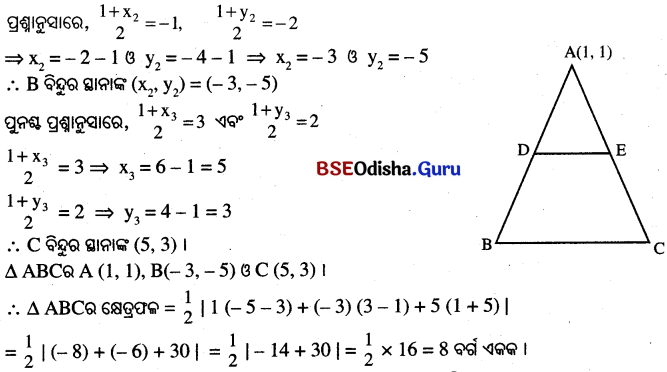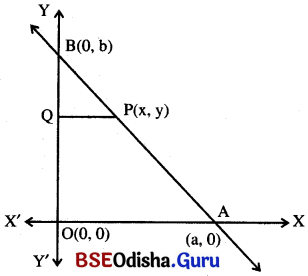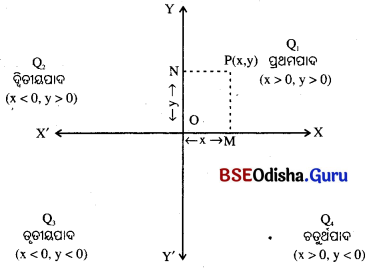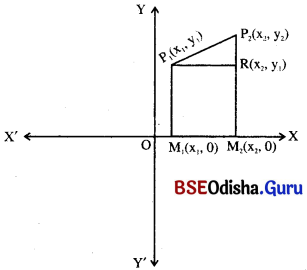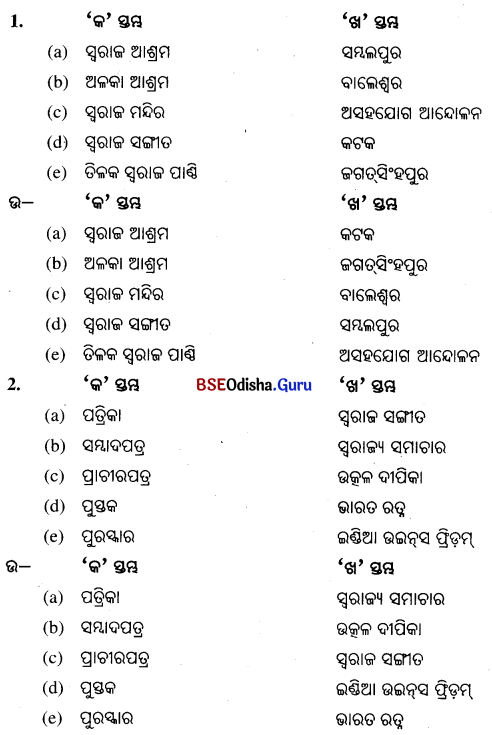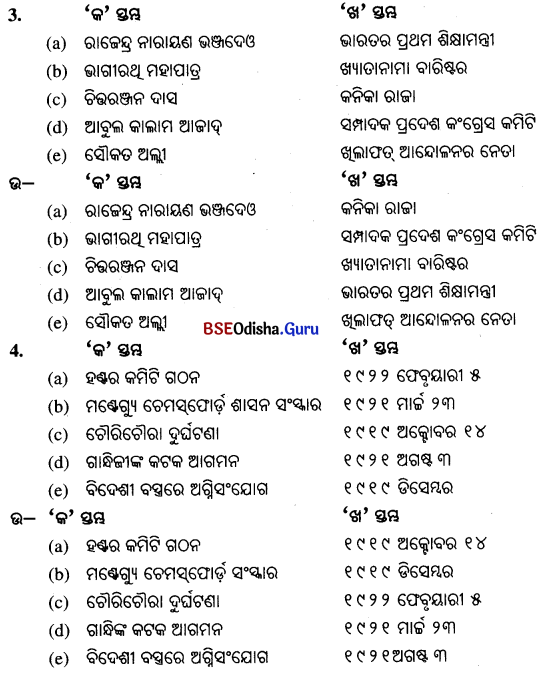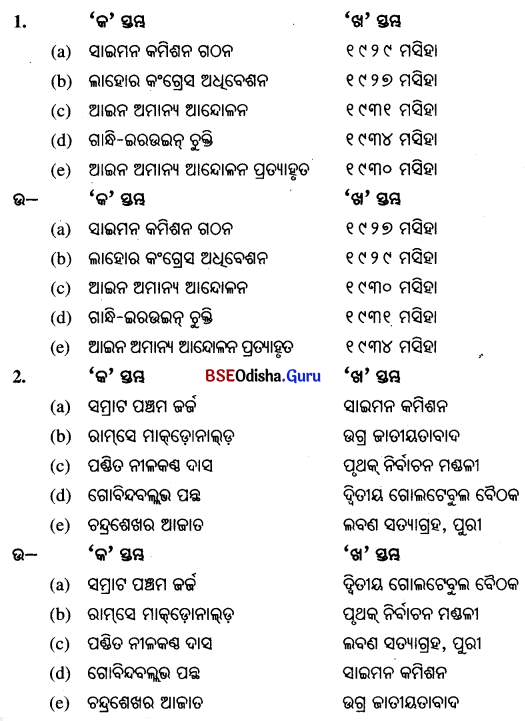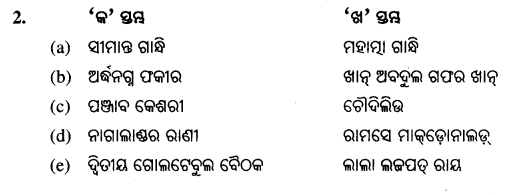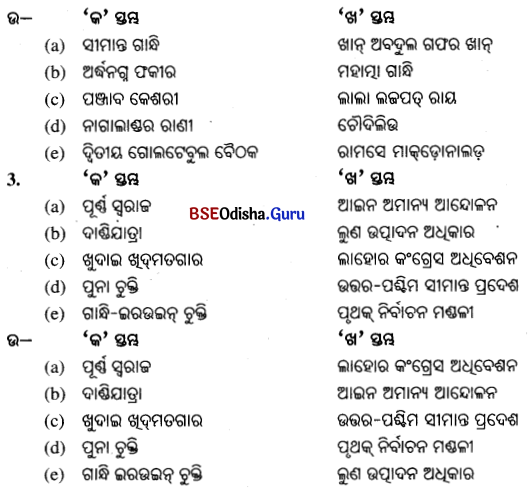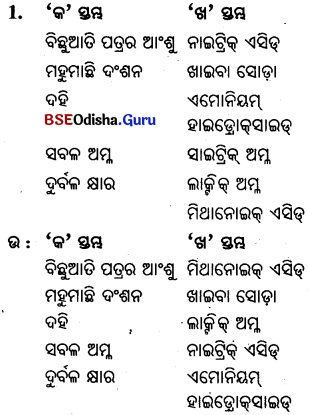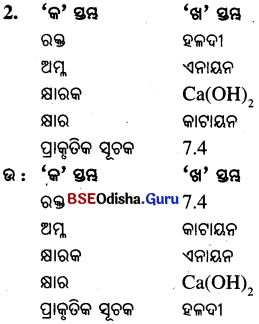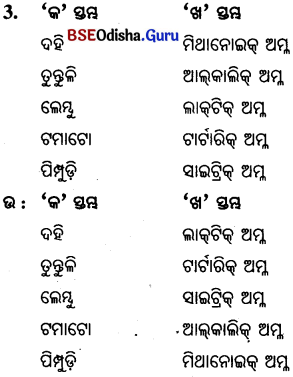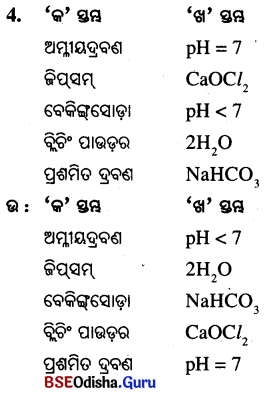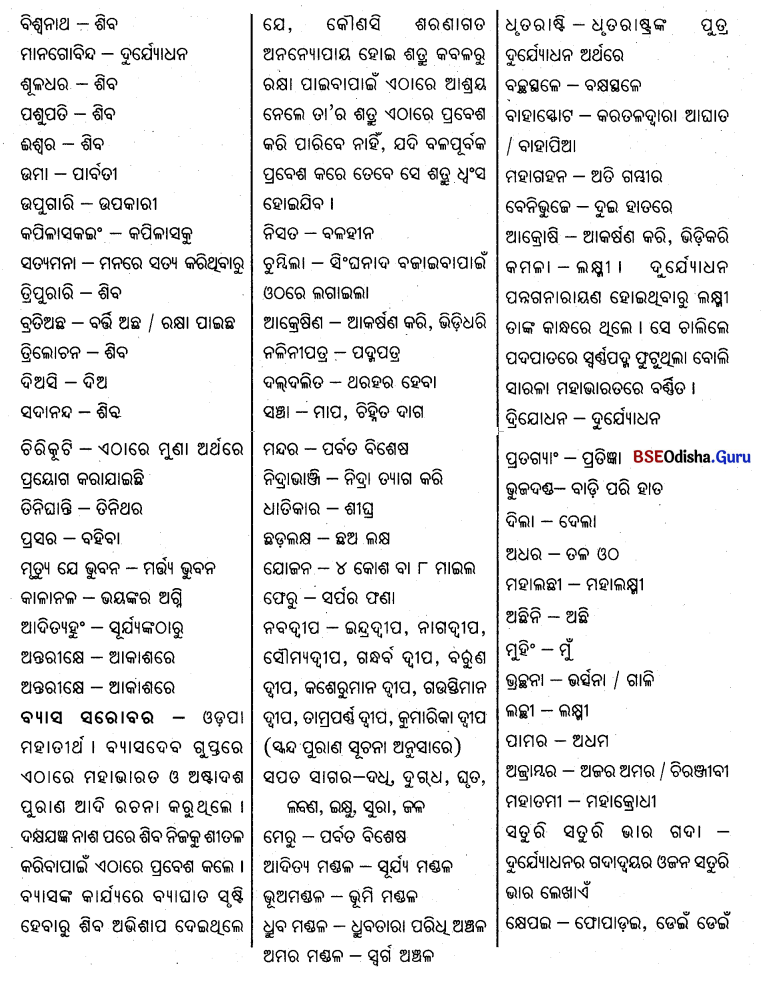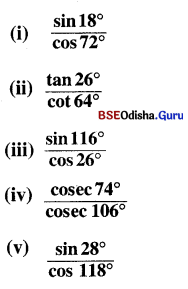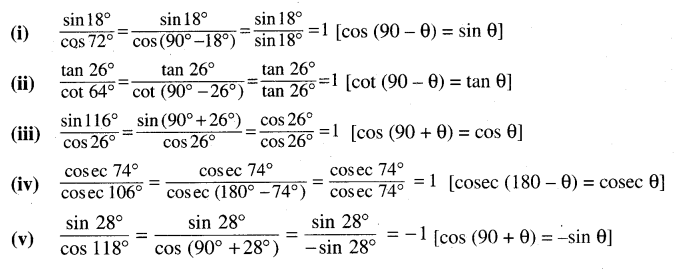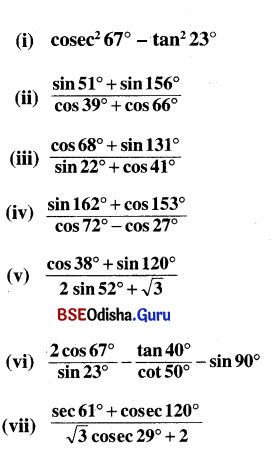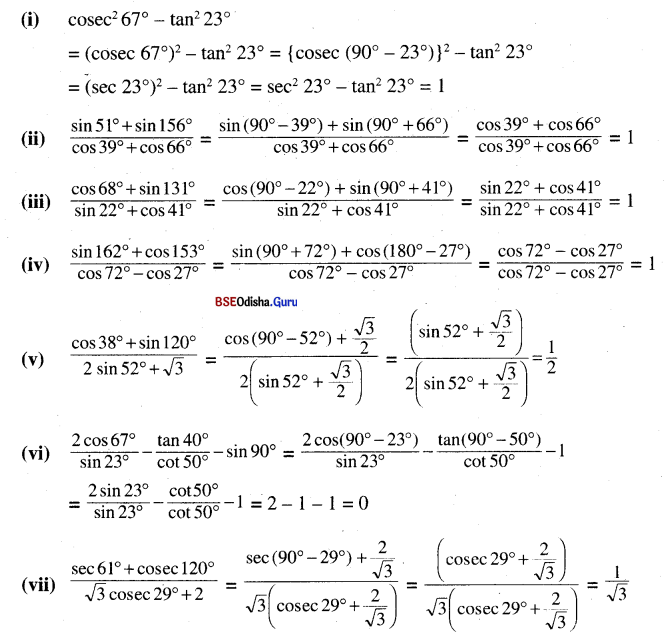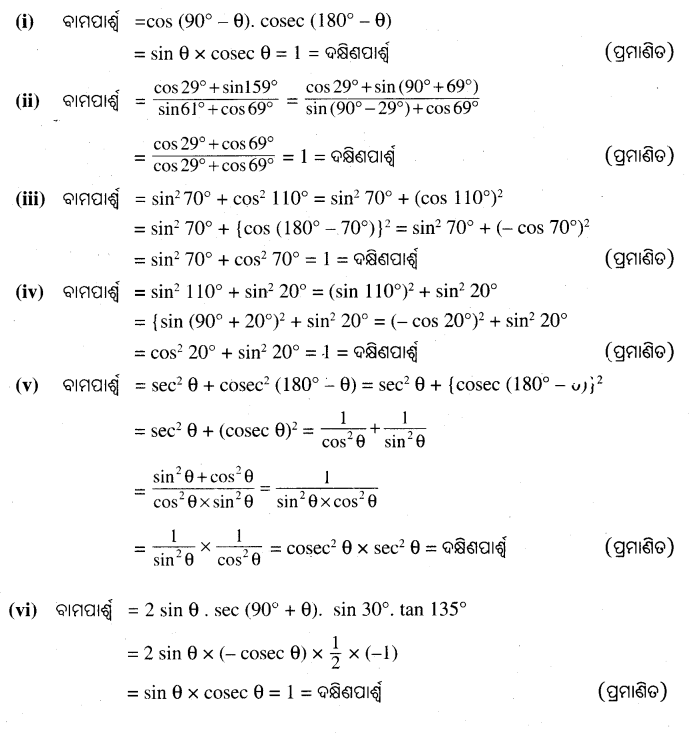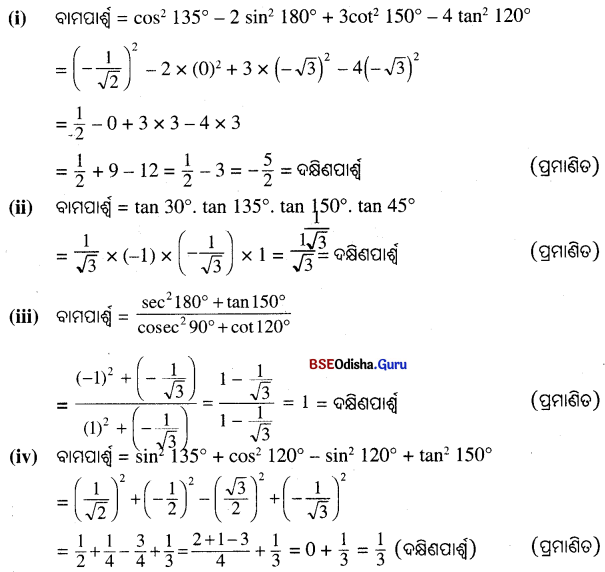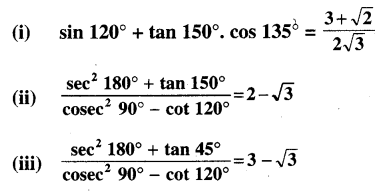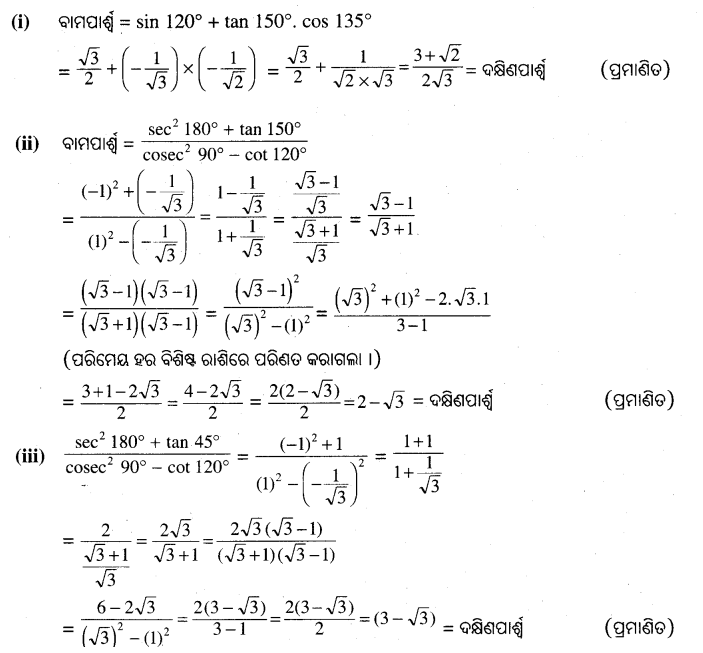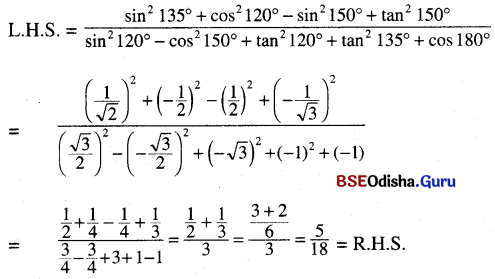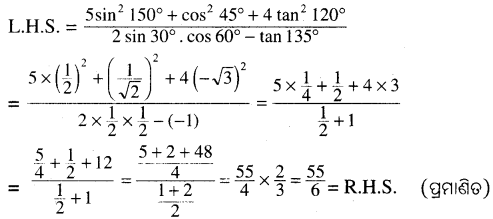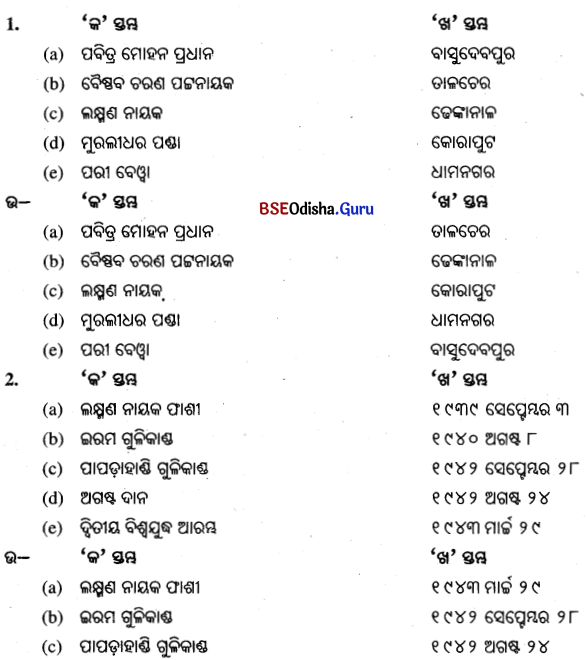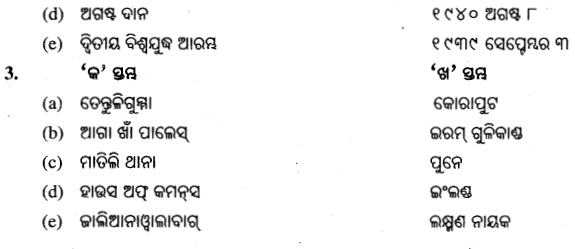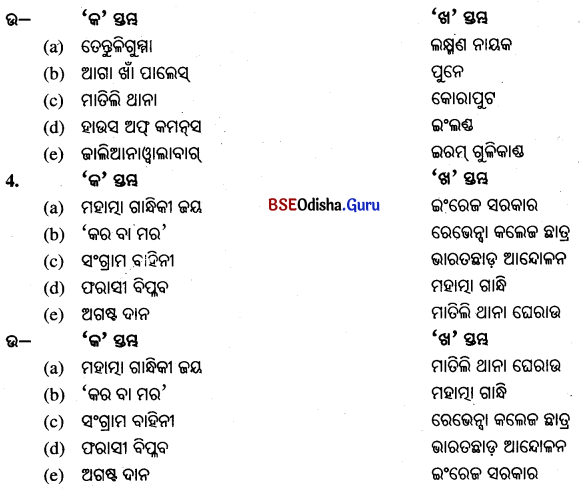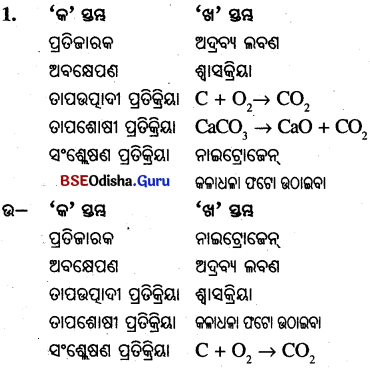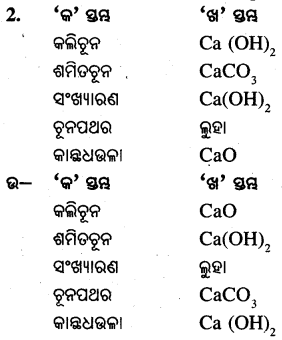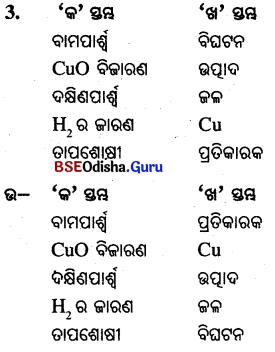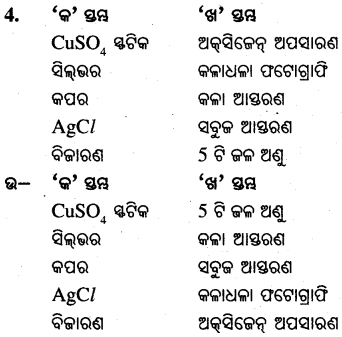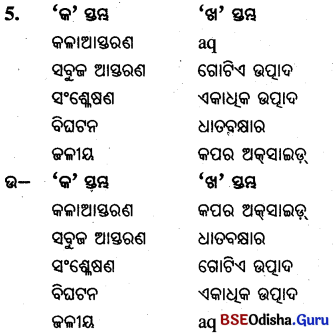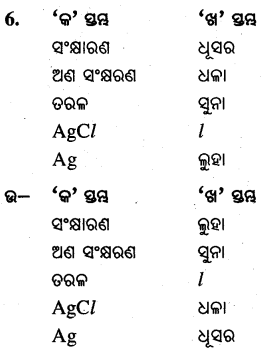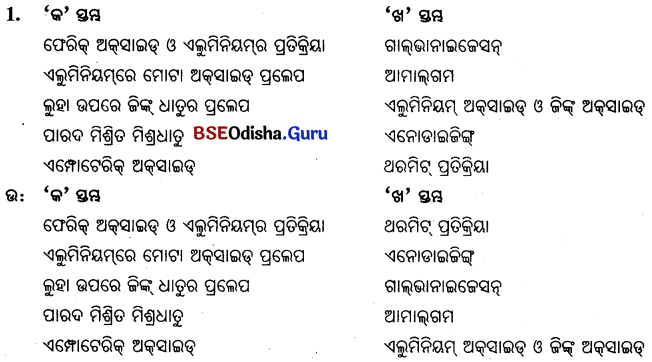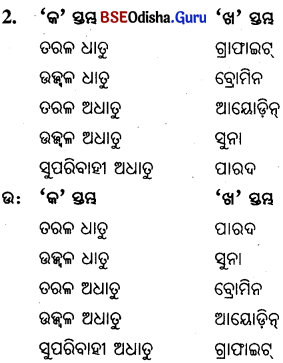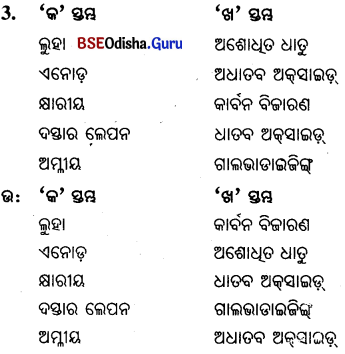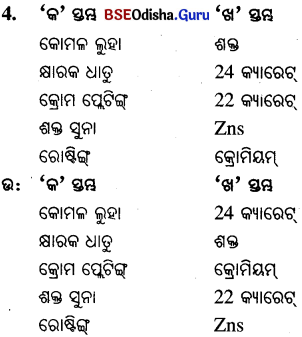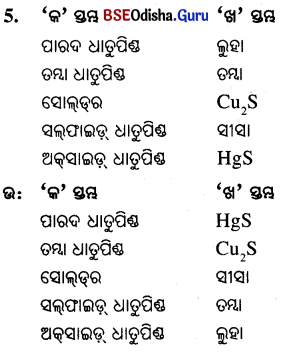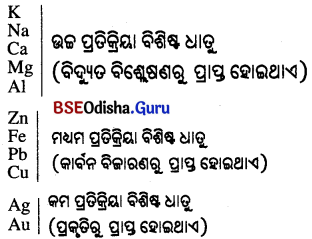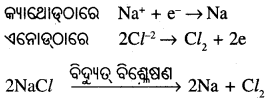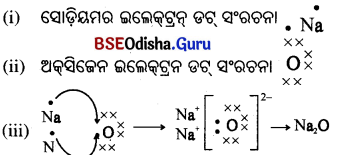Odisha State Board BSE Odisha 10th Class Life Science Important Questions Chapter 5 ନିୟନ୍ତ୍ରଣ ଓ ସମନ୍ଵୟ Important Questions and Answers.
BSE Odisha Class 10 Life Science Important Questions Chapter 5 ନିୟନ୍ତ୍ରଣ ଓ ସମନ୍ଵୟ
Objective Type Questions with Answers
A ଗୋଟିଏ ବାକ୍ୟରେ ଉତ୍ତର ଦିଅ ।
1. ଶରୀରରେ ବିଭିନ୍ନ ଅଙ୍ଗ ସଂସ୍ଥାନର ନିୟନ୍ତ୍ରଣ ଓ ସମନ୍ଵୟ ରକ୍ଷା କିପରି ହୋଇଥାଏ ?
ଊ-
ଆମ ଶରୀରର ବିଭିନ୍ନ ଅଙ୍ଗ ସଂସ୍ଥାନର ନିୟନ୍ତ୍ରଣ ଏବଂ ସେଗୁଡ଼ିକ ମଧ୍ୟରେ ସମନ୍ଵୟ ରକ୍ଷାପାଇଁ 2 ପ୍ରକାର ପଦ୍ଧତି ରହିଛି ଯଥା-
- ସ୍ନାୟବିକ ପଦ୍ଧତି,
- ରାସାୟନିକ ପଦ୍ଧତି ।
2. ସ୍ନାୟବିକ ପଦ୍ଧତିରେ କାର୍ଯ୍ୟ ତୁ ର ନ୍ତ ହେଉଥିବାବେଳେ ରାସାୟନିକ ପଦ୍ଧତିରେ କାର୍ଯ୍ୟ ମନ୍ଥର ହୋଇଥାଏ’- କାରଣ ଦର୍ଶାଅ ।
ଉ-
ସ୍ନାୟବିକ ପଦ୍ଧତିରେ ସ୍ନାୟୁକୋଷ ମାଧ୍ୟମରେ ଖବର ବିଦ୍ୟୁତ୍ ରାସାୟନିକ କ୍ରିୟାଦ୍ଵାରା ସଞ୍ଚାରିତ ହୁଏ; କିନ୍ତୁ ରାସାୟନିକ ପଦ୍ଧତିରେ ଅନ୍ତଃସ୍ରାବୀ ଗ୍ରନ୍ଥିରୁ କ୍ଷରିତ ବିଭିନ୍ନ ହର୍ମୋନ୍ଦ୍ବାରା ବାର୍ତ୍ତା ପ୍ରସାରିତ ହୁଏ ।
![]()
3. ଆମ ଶରୀରର ଅନ୍ତଃସ୍ରାବୀ ତନ୍ତ୍ରକୁ ‘ସ୍ନାୟୁ- ଅନ୍ତଃସ୍ରାବୀ ତନ୍ତ୍ର’’ କାହିଁକି କୁହାଯାଏ ?
ଉ-
ସମସ୍ତ ଅନ୍ତଃସ୍ରାବୀ ଗ୍ରନ୍ଥିକୁ ନେଇ ଆମ ଶରୀରର ‘‘ଅନ୍ତଃସ୍ରାବୀ ତନ୍ତ୍ର’’ ଗଠିତ ଏବଂ ସ୍ନାୟୁତନ୍ତ୍ର ଓ ଅନ୍ତଃସ୍ରାବୀ ତନ୍ତ୍ର ପରସ୍ପର ମଧ୍ୟରେ ସମନ୍ଵୟ ରକ୍ଷାକରି କାର୍ଯ୍ୟ କରୁଥିବାରୁ ଏହାକୁ ସ୍ନାୟୁ-ଅନ୍ତଃସ୍ରାବୀ ତନ୍ତ୍ର କୁହାଯାଏ ।
4. ରିଲିଜିଙ୍ଗ ହରମୋନ୍ର କାର୍ଯ୍ୟ ଲେଖ ।
ଉ-
ହାଇପୋଥାଲମସ୍ତୁରୁ ରିଲିଜିଙ୍ଗ୍ ହରମୋନ୍ ଏବଂ ଇନ୍ ହିବିଟିଙ୍ଗ ହର୍ ମୋନ୍ କ୍ଷରିତ ହୁଏ । ଏହି ନିୟନ୍ତ୍ରଣ କରିଥା’ନ୍ତି ।
5. ପିଟୁଇଟାରି ଗ୍ରନ୍ଥିର ଗଠନ ଲେଖ ।
ଉ-
ପିଟୁଇଟାରି ଗ୍ରନ୍ଥି ହାଇପୋଥାଲାମସ୍ ସହ ଗୋଟିଏ ଛୋଟ ବୃନ୍ତ ସାହାଯ୍ୟରେ ଲାଗି ରହିଥାଏ ଏବଂ ଏହା ଏଡ଼ି ନୋ ହାଇପୋଫାଇସିସ୍ ଓ ନିଉରୋ ହାଇପୋଫାଇସିସ୍ ନାମକ ଦୁଇଟି ପୃଥକ୍ ଖଣ୍ଡକୁ ନେଇ ଗଠିତ ।
6. ପ୍ରୋଲାକ୍ଟିନ୍ ଗ୍ରନ୍ଥିର କାର୍ଯ୍ୟ ଲେଖ ।
ଉ-
ଏହା ମାଆର ସ୍ତନ୍ୟଗ୍ରନ୍ଥି ଉପରେ ପ୍ରଭାବ ପକାଏ ଏବଂ ଏହାଦ୍ଵାରା ଶିଶୁ ପାଇଁ ସେଥିରେ କ୍ଷୀର ପ୍ରସ୍ତୁତ ହୁଏ ।
7. ଫଲିକଲ୍ ଷ୍ଟିମୁଲେଟିଙ୍ଗ୍ ହରମୋନ୍ର କାର୍ଯ୍ୟ କ’ଣ ?
ଊ-
ଏହି ହରମୋନ୍ ଡିମ୍ବାଶୟ ପୁଟିକାର ବୃଦ୍ଧି କରାଏ ।
8. ଅକ୍ସିଟୋସିନ୍ ହରମୋନ୍ର କାର୍ଯ୍ୟ ଲେଖ ।
ଉ-
ଏହି ହର୍ମୋନ୍ ସ୍ତନ୍ୟଗ୍ରନ୍ଥିରୁ କ୍ଷୀର ଝରାଏ ଓ ପ୍ରସବ ପକାଏ ଓ ଗର୍ଭାଶୟର ସଙ୍କୋଚନ ଫଳରେ ଶିଶୁ ଜନ୍ମ ହୁଏ ।
9. କେଉଁ ହର୍ମୋନ୍ ଶରୀରରେ ଜୈବିକ ଘଡ଼ି ପରି କାର୍ଯ୍ୟ କରେ ?
ଉ-
ପିନିଆଲ ଗ୍ରନ୍ଥିରୁ କ୍ଷରିତ ମେଲାଟୋନିନ୍ ନାମକ ହରମୋନ୍ର ପ୍ରଭାବ ଯୁବକ୍ରାନ୍ତି, ଡିମ୍ବୋତ୍ସର୍ଗ ବା ଡିମ୍ବୋଦୟ ଓ ନିଦ୍ରା ଉପରେ ପଡୁଥିବାରୁ ଜୈବିକ ଘଡ଼ି ଭାବେ କାର୍ଯ୍ୟ କରେ ।
10. କେଉଁ ଗ୍ରନ୍ଥିକୁ ‘ଆପଦକାଳୀନ ଗ୍ରନ୍ଥି’ କୁହାଯାଏ ? କାରଣ ଦର୍ଶାଅ ।
ଉ-
ଏଡ୍ରିନାଲ୍ ଗ୍ରନ୍ଥିରୁ କ୍ଷରିତ ଏଡ୍ରିନାଲିନ୍ ନାମକ ହରମୋନ୍ ଆକସ୍ମିକ ଆଘାତ, ଭୟ, ଅବଶ ଓ ଉତ୍ତେ ଜି ତ ଅବସ୍ଥାରେ କ୍ଷରିତ ହେଉଥିବାରୁ ଏହି ଗ୍ରନ୍ଥି କୁ ଆପଦକାଳୀନ ଗ୍ରନ୍ଥି କୁହାଯାଏ ।
B. ଗୋଟିଏ ଶବ୍ଦରେ ଉତ୍ତର ଦିଅ ।
- କରୋଟି ସ୍ନାୟୁ ଓ ସୁଷୁମ୍ନା ସ୍ନାୟୁକୁ ନେଇ କେଉଁ ସ୍ନାୟୁତନ୍ତୁ ଗଠିତ ହୋଇଛି ?
- ମସ୍ତିଷ୍କ କାହା ଭିତରେ ସୁରକ୍ଷିତ ହୋଇ ରହିଛି ?
- ପଶ୍ଚି ଅଗ୍ର ମସ୍ତିଷ୍କର ଉପରି ଭାଗରେ କେଉଁ ଗ୍ରନ୍ଥି ରହିଛି ?
- ଗୋଟିଏ ନବଜାତ ଶିଶୁର ମସ୍ତିଷ୍କର ଓଜନ ପ୍ରାୟ କେତେ ଗ୍ରାମ୍ ?
- ଶରୀରର ସମସ୍ତ ଅନୈଚ୍ଛିକ କ୍ରିୟାର ନିୟନ୍ତ୍ରଣରେ କେଉଁ ସ୍ନାୟୁତନ୍ତ୍ରର ଭୂମିକା ରହିଛି ?
- ଗ୍ରାହୀ ଅଙ୍ଗରୁ ଆବେଗ ସଂଗ୍ରହ କରୁଥିବା ସ୍ନାୟୁମାନଙ୍କୁ କ’ଣ କୁହାଯାଏ ?
- ମସ୍ତିଷ୍କର ନିର୍ଦ୍ଦେଶରେ ପରିଚାଳିତ କାର୍ଯ୍ୟଗୁଡ଼ିକୁ କ’ଣ କୁହାଯାଏ ?
- ସ୍ନାୟୁକୋଷର ନ୍ୟଷ୍ଟି ଥିବା ଅଂଶକୁ କ’ଣ କୁହାଯାଏ ?
- ମଧ୍ୟମସ୍ତିଷ୍କର ନିମ୍ନ ଭାଗର ଦୁଇଟି ପିଣ୍ଡ କେଉଁ ସମ୍ବନ୍ଧୀୟ ପ୍ରତିକ୍ଷେପକୁ ନିୟନ୍ତ୍ରଣ କରେ ?
- ପଶ୍ଚିମସ୍ତିଷ୍କର ଅଗ୍ରଭାଗରେ କେଉଁ ଅଂଶ ଅବସ୍ଥାନ କରିଥାଏ ?
- ମଣିଷଠାରେ କେତେ ଯୋଡ଼ା କରୋଟି ସ୍ନାୟୁ ଅଛି ?
- ଆମ ଶରୀରରେ ଥିବା ଆଖୁ, ନାକ, କାନ, ଜିଭ ଓ ଚର୍ମ ଇତ୍ୟାଦି କ’ଣ ଅଟନ୍ତି ?
- ଶରୀର ମଧ୍ୟରେ ଆପଣାଛାଏଁ ସମ୍ପାଦିତ ହେଉଥିବା କ୍ରିୟାକୁ କ’ଣ କୁହାଯାଏ ?
- କେଉଁଟି ଆମ ଶରୀରର ସବୁଠାରୁ ଲମ୍ବା କୋଷ ଅଟେ ?
- ଦୁଇଟି ସ୍ନାୟୁକୋଷର ମିଳନ ସ୍ଥଳକୁ କ’ଣ କୁହାଯାଏ ?
- କେଉଁ ଗ୍ରନ୍ଥି ଆମ ଶରୀରର ହୃତ୍ସ୍ପନ୍ଦନ, ରକ୍ତଚାପ, ନିଦ୍ରା ଓ ଭୟ, ରାଗ, ଆନନ୍ଦ ଇତ୍ୟାଦିକୁ ନିୟନ୍ତ୍ରଣ କରେ ?
Answers
- ପ୍ରାନ୍ତୀୟ ସ୍ନାୟୁତନ୍ତ୍ର
- ଖପୁରି
- ପିନିଆଲ
- 400
- ସ୍ଵୟଂକ୍ରିୟ
- ସେନ୍ସରୀ ସ୍ନାୟୁ
- ଐଚ୍ଛିକ କ୍ରିୟା
- ସେଲ୍ବଡ଼ି
- ଶ୍ରବଣ
- ଅନୁମସ୍ତିଷ୍କ
- 12
- ଗ୍ରାହୀ ଅଙ୍ଗ
- ଅନୈକ୍ଷିକ କ୍ରିୟା
- ସ୍ନାୟୁ କୋଷ
- ସିନାପସ୍ .
- ହାଇପୋଥାଲାମସ୍
![]()
C ଶୂନ୍ୟସ୍ଥାନ ପୂରଣ କର ।
1. ଆପଦକାଳୀନ ଗ୍ରନ୍ଥି …………….. କୁ କୁହାଯାଏ ।
2. ଗର୍ଭାବସ୍ଥାରେ ………………….. ହରମୋନ୍ କାର୍ଯ୍ୟ କରେ ।
3. ଅଗ୍ନାଶୟର ହର୍ ମୋନ୍ କ୍ଷରଣ କରୁଥିବା ଅଂଶକୁ …………………. କୁହାଯାଏ ।
4. α- କୋଷରୁ ………………… ହର୍ମୋନ୍ କ୍ଷରିତ ହୁଏ ।
5. B- କୋଷରୁ ………………. ହର୍ମୋନ୍ କ୍ଷରିତ ହୁଏ ।
6. σ କୋଷରୁ …………………… ହର୍ମୋନ୍ କ୍ଷରିତ ହୁଏ ।
7. ଇନ୍ସୁଲିନ୍ ଶରୀରରେ ……………………. ର ପରିମାଣ ସ୍ଥିର ରଖେ ।
8. ଇନ୍ସୁଲିନ୍ର ଅଭାବରେ ରକ୍ତରେ ଶର୍କରା ପରିମାଣ ବଢ଼ି ………………….. ରୋଗ ହୁଏ ।
9. ଶୁକ୍ରାଶୟ ମଧ୍ୟରେ ……………………… ରୁ ଟେଷ୍ଟୋଷ୍ଟିରନ୍ ନାମକ ଏକ ପୁରୁଷ ହର୍ମୋନ୍ କ୍ଷରିତ ହୁଏ ।
10. ଟେଷ୍ଟୋଷ୍ଟିରନ୍ …………………… ଉତ୍ପତ୍ତିରେ ସହାୟକ ହୁଏ ।
11. ଗର୍ଭଧାରଣରେ ଗୁରୁତ୍ଵପୂର୍ଣ ଭୂମିକା ଥିବାରୁ …………………… ହର୍ମୋନକୁ ଗର୍ଭାବସ୍ଥାର ହର୍ମୋନ୍ କୁହାଯାଏ ।
12. ଆକସ୍ମିକ ଆଘାତ, ଭୟ, ଅବଶ ଓ ଉତ୍ତେଜିତ ଅବସ୍ଥାରେ ………………… ଗ୍ରନ୍ଥି ରୁ ହରମୋନ୍ କ୍ଷରିତ ହେଉଥିବାରୁ ଏହାକୁ ‘ଆପଦକାଳୀନ ଗ୍ରନ୍ଥି’ କୁହାଯାଏ ।
13. ଗର୍ଭବତୀ ମହିଳାଙ୍କର ମୂତ୍ର ସହିତ ମିଶି …………………….. ହରମୋନ୍ ଶରୀର ବାହାରକୁ ଆସେ ।
14. ଆମ ଶରୀରରେ ………………… ସଙ୍କେତ ନିୟନ୍ତ୍ରଣ କୁହାଯାଏ । ସଙ୍କେତ ନିୟନ୍ତ୍ରଣ କୁହାଯାଏ ।
15. ଫାଇଟୋହରମୋନ୍ ମୁଖ୍ୟତଃ …………………….. ପ୍ରକାର ।
16. ମସ୍ତିଷ୍କ …………………. ଭାଗରେ ବିଭକ୍ତ ।
17. ଅଗ୍ରମସ୍ତିଷ୍କର ନିମ୍ନଭାଗରେ ଥିବା …………………… ଗ୍ରନ୍ଥିର କ୍ଷରଣକୁ ନିୟନ୍ତ୍ରଣ କରେ ।
18. ଦୁଇଟି ବୃକ୍କର ଉପରିଭାଗକୁ ଲାଗି ଦୁଇଟି ……………………. ଗ୍ରନ୍ଥି ଅଛି ।
Answers
1. ଏଡ୍ରିନାଲ ଗ୍ରନ୍ଥ
2. ପ୍ରୋଜିଷ୍ଟିରନ୍
3. ଆଇଲେସ୍ ଅଫ ଲାଙ୍ଗରହାନ୍ସ
4. ଗ୍ଲା କାଗନ୍
5. ଇନ୍ସୁଲିନ୍
6. . ସୋମାଟୋଷ୍ଟାଟିନ୍
7. ଶର୍କରା
8. ମଧୁମେହ
9. ଲେଡ଼ିଗ୍ କୋଷ
10. ଶୁକ୍ରାଣୁ
11. ପ୍ରୋଜିଷ୍ଟିରନ୍
12. ଏଡ୍ରିନାଲ ଗ୍ରନ୍ଥି
13. HCG
14. ହରମୋନ୍
15. 5
16. 3
17. ହାଇପୋଥାଲାମସ୍
18. ଏଡ୍ରିନାଲ
D ଠିକ୍ ଉକ୍ତି ପାଇଁ (✓) ଓ ଭୁଲ୍ ଉକ୍ତି ପାଇଁ (✗) ଚିହ୍ନ ଦିଅ ।
1. ପତ୍ରରେ ଫ୍ଲୋରି ଜେନ୍ ନାମକ ହରମୋନ୍ ଓ ଫାଇଟୋକ୍ରୋମ୍ ନାମକ ବର୍ଷକଣା ଫୁଲ ଧରି ବା ପ୍ରକ୍ରିୟାକୁ ନିୟନ୍ତ୍ରଣ କରିଥାଏ ।
2. ମୂଳର ଯେଉଁ ଅଂଶରେ ହରମୋନ୍ର ସାନ୍ଦ୍ରତା କମ୍ ହୁଏ, ସେଠାରେ ବୃଦ୍ଧି ମଧ୍ଯ କମ୍ ହୁଏ ।
3. ପଶ୍ଚିମସ୍ତିଷ୍କର ଉପରିଭାଗରେ ହାଇପୋଥାଲାମସ୍ ଓ ନିମ୍ନଭାଗରେ ପିନିଆଲ ଗ୍ରନ୍ଥି ଥାଏ ।
4. ମଣିଷଠାରେ 12 ଯୋଡ଼ା କରୋଟି ସ୍ନାୟୁ ଓ 31 ଯୋଡ଼ା ସୁଷୁମ୍ନା ସ୍ନାୟୁ ଥାଏ ।
5. ଅଗ୍ନାଶୟରୁ ଉଭୟ ହରମୋନ୍ ଓ ଏନ୍ଜାଇମ୍ କ୍ଷରଣ ହୁଏ ।
6. ମସ୍ତିଷ୍କ -ମେରୁରସ ମସ୍ତିଷ୍କକୁ ବାୟୁମଣ୍ଡଳର ଚାପରୁ ରକ୍ଷାକରେ ।
7. ପ୍ରତି ମିନିଟ୍ରେ ମସ୍ତିଷ୍କ ମଧ୍ୟକୁ ପ୍ରାୟ 500 ମିଲି ଲି. ରକ୍ତ ପ୍ରବାହିତ ହୁଏ ।
8. ଅଗ୍ରମସ୍ତିଷ୍କର ଘ୍ରାଣପାଳି ଭାଗଟି ମନୁଷ୍ୟଠାରେ ଅତି କ୍ଷୀଣ ଭାବେ ରହିଛି ।
9. ପଶ୍ଚ ଅଗ୍ରମସ୍ତିଷ୍କର ଭାଗରେ ହାଇପୋଥାଲାମସ୍ ଗ୍ରନ୍ଥି ରହିଛି ।
10. ମଧ୍ୟମସ୍ତିଷ୍କ 2 ଯୋଡ଼ା ବର୍ତ୍ତୁଳ ନିଦା ପିଣ୍ଡକୁ ନେଇ ଗଠିତ ।
11. ମଧ୍ଯ ମସ୍ତିଷ୍କର ଉପର ଦୁଇଟି ପିଣ୍ଡ ଶ୍ରବଣ ସମ୍ବନ୍ଧୀୟ ପ୍ରତିକ୍ଷେପକୁ ନିୟନ୍ତ୍ରଣ କରେ ।
12. ମସ୍ତିଷ୍କର ପିଣ୍ଡଚତୁଷ୍କ ଅଂଶ ସନ୍ତୁଳନ ଓ ଭାରସାମ୍ୟ ରକ୍ଷା କରେ ।
13. ମନୁଷ୍ୟ ଶରୀରର ସୁଷୁମ୍ନାକାଣ୍ଡର ଲମ୍ବ 45 ସେ.ମି. ।
14. ମନୁଷ୍ୟଠାରେ 31 ଯୋଡ଼ା ସୁଷୁମ୍ନା ସ୍ନାୟୁ ରହିଛି ।
15. ମାନବ ସ୍ନାୟୁତନ୍ତ୍ରକୁ ଆମେ 4 ଭାଗରେ ବିଭକ୍ତ କରିପାରିବା ।
16. ପିଣ୍ଡଚତୁଷ୍କ ଅଗ୍ର ମସ୍ତିଷ୍କର ଅଂଶବିଶେଷ ଅଟେ ।
17. ସୁଷୁମ୍ନା ସ୍ନାୟୁ ସୁଷୁମ୍ନାକାଣ୍ଡରୁ ବାହାରିଥାଏ ।
Answers
1. (✓)
2. (✗)
3. (✗)
4. (✓)
5. (✓)
6. (✓)
7. (✗)
8. (✓)
9. (✓)
10. (✓)
11. (✗)
12. (✗)
13. (✓)
14. (✓)
15. (✗)
16. (✗)
17. (✔)
![]()
E ‘କ’ ସ୍ତମ୍ଭରେ ପ୍ରଥମ ଯୋଡାର ସମ୍ପର୍କକୁ ଲକ୍ଷ୍ୟକରି ‘ଖ’ ସ୍ତମ୍ଭରେ ଦ୍ଵିତୀୟଟିରେ ଶୂନ୍ୟସ୍ଥାନ ପୂରଣ କର ।
| 1. ‘କ’ ସ୍ତମ୍ଭ | ‘ଖ’ ସ୍ତମ୍ |
| ବାମନତା : ଗ୍ରୋଥ୍ ହରମୋନ୍ | ରୂପାନ୍ତରଣ : |
| ଡିମ୍ବାଶୟ କଷ୍ଟୋକେନ | ଶୁକ୍ରାଶୟ : |
| ଫୁଲ ଝଡ଼ିବା : ଏଥୁଲିନ୍ | ଫୁଲ ଧରିବା : |
| ଏଡ୍ରିନାଲ ଗ୍ରନ୍ଥି : ଅନ୍ତଃସ୍ରାବୀ | ଯକୃତ୍ : |
| ଚେର : ଅନୁକୂଳ ଜ୍ୟାନୁବର୍ତ୍ତନ | କାଣ୍ଡ : |
Answers
| ‘କ’ ସ୍ତମ୍ଭ | ‘ଖ’ ସ୍ତମ୍ |
| ବାମନତା : ଗ୍ରୋଥ୍ ହରମୋନ୍ | ରୂପାନ୍ତରଣ : ଥାଇରକସିନ୍, |
| ଡିମ୍ବାଶୟ କଷ୍ଟୋକେନ | ଶୁକ୍ଳାଶୟ : ଟେଷ୍ଟୋଷ୍ଟିରନ୍ |
| ଫୁଲ ଝଡ଼ିବା : ଏଥୁଲିନ୍ | ଫୁଲ ଧରିବା : ଫ୍ଲୋରିଜେନ ଓ |
| ଏଡ୍ରିନାଲ ଗ୍ରନ୍ଥି : ଅନ୍ତଃସ୍ରାବୀ | ଯକୃତ୍ : ବହିଃସ୍ରାବୀ ଗ୍ରନ୍ଥି |
| ଚେର : ଅନୁକୂଳ ଜ୍ୟାନୁବର୍ତ୍ତନ | କାଣ୍ଡ : ପ୍ରତିକୂଳ ଜ୍ୟାନବର୍ତ୍ତନ |
| 2. ‘କ ସ୍ତମ୍ଭ | ‘ଖ’ ସ୍ତମ୍ |
| ମଣିଷ : ଦୂର୍ବଳଘ୍ରାଣ ପାଳି | କୁକୁର : |
| ଏଡ୍ରିନାଲ : 2 | ଅଗ୍ନାଶୟ : |
| ପିଟୁଇଟାଲୀ : ଅନ୍ତଃସ୍ରାବୀ | ଲାଳଗ୍ରନ୍ଥି : |
| ଅକ୍ସିନ୍ : ବୃଦ୍ଧିକାରକ ହରମୋନ୍ | ଏଥିଲିନ୍ : |
| GH ହ୍ରାସ : ବାମନତା | GH ବୃଦ୍ଧି : |
Answers
| ‘କ ସ୍ତମ୍ଭ | ‘ଖ’ ସ୍ତମ୍ |
| ମଣିଷ : ଦୂର୍ବଳଘ୍ରାଣ ପାଳି | କୁକୁର : ଭକତ ଘ୍ରାଣପାଳି |
| ଏଡ୍ରିନାଲ : 2 | ଅଗ୍ନାଶୟ : 1 |
| ପିଟୁଇଟାଲୀ : ଅନ୍ତଃସ୍ରାବୀ | ଲାଳଗ୍ରନ୍ଥି : ବାହ୍ୟସ୍ରାବୀ |
| ଅକ୍ସିନ୍ : ବୃଦ୍ଧିକାରକ ହରମୋନ୍ | ଏଥୁଲିନ୍: ବୃଦ୍ଧିହାସକ ହରମୋନ |
| GH ହ୍ରାସ : ବାମନତା | GH ବୃଦ୍ଧି : ଅତିକାୟତ |
| 3 ‘କ ସ୍ତମ୍ଭ | ‘ଖ’ ସ୍ତମ୍ |
| ମସ୍ତିଷ୍କ : ଖପୁରି | ସୁଷୁମ୍ନାକାଣ୍ଡ୍ : |
| ଖାଇବା : ଐତ୍ମିକ କ୍ରିୟା | ଖାଦ୍ୟ ପରିପାକ : |
| ମସ୍ତିଷ୍କ : କେନ୍ଦ୍ରୀୟ ସ୍ନାୟୁତନ୍ତ୍ର | କ୍ରାନିଆଲ୍ ସ୍ନାୟୁ : |
| ନାଳଯୁକ୍ତ : ବହିଃସ୍ରାବୀ ଗ୍ରନ୍ଥି | ନାଳବିହୀନ : |
| ବହିଃସ୍ରାବୀ ଗ୍ରନ୍ଥି : ଏନ୍ଜାଇମ୍ | ଅନ୍ତଃସ୍ରାବୀ ଗ୍ରନ୍ଥି : |
Answers
| ‘କ ସ୍ତମ୍ଭ | ‘ଖ’ ସ୍ତମ୍ |
| ମସ୍ତିଷ୍କ : ଖପୁରି | ସୁଷୁମ୍ନାକାଣ୍ଡ : ମେରୁଦଣ୍ଡ |
| ଖାଇବା : ଐତ୍ମିକ କ୍ରିୟା | ଖାଦ୍ୟ ପରିପାକ : ଅନୈଚ୍ଛିକ |
| ମସ୍ତିଷ୍କ : କେନ୍ଦ୍ରୀୟ ସ୍ନାୟୁତନ୍ତ୍ର | କ୍ରାନିଆଲ୍ ସ୍ନାୟୁ : ପ୍ରାନ୍ତୀୟ |
| ନାଳଯୁକ୍ତ : ବହିଃସ୍ରାବୀ ଗ୍ରନ୍ଥି | ନାଳବିହୀନ : ଅନ୍ତଃସ୍ରାବୀ ଗ୍ରନ୍ଥୀ |
| ବହିଃସ୍ରାବୀ ଗ୍ରନ୍ଥି : ଏନ୍ଜାଇମ୍ | ଅନ୍ତଃସ୍ରାବୀ ଗ୍ରନ୍ଥି : ହର୍ମୋନ |
Multiple Choice Questions (Mcqs) With Answers
1. ମଣିଷ ଶରୀରରେ କେତେ ଯୋଡ଼ା କରୋଟି ସ୍ନାୟୁ ଅଛି ?
(A) 31
(C) 10
(B) 15
(D) 12
Answer
(D) 12
![]()
2. ଘ୍ରାଣ ପାଳି କେଉଁ ଅଂଶରେ ଥାଏ ?
(A) ମଧ୍ୟ ମସ୍ତିଷ୍କ
(B) ଅଗ୍ର ମସ୍ତିଷ୍କ .
(C) ପଶ୍ଚ ମସ୍ତିଷ୍କ
(D) ସୁଷୁମ୍ନା କାଣ୍ଡ
Answer
(B) ଅଗ୍ର ମସ୍ତିଷ୍କ .
3. କେଉଁଥ img ହୁ ଏ ?
(A) ଡିମ୍ବାଶୟ
(B) ଶୁକ୍ରାଶୟ
(C) ଅଗ୍ନ୍ୟାଶୟ
(D) ଯକୃତ
Answer
(C) ଅଗ୍ନ୍ୟାଶୟ
4. ବୃକ୍କରୁ କ୍ଷରିତ କେଉଁ ହରମୋନ୍ ଲୋହିତ ରକ୍ତ କଣିକା ତିଆରିରେ ସହାୟକ ହୋଇଥାଏ ?
(A) ଅକ୍ସିଟୋସିନ୍
(B) ଏରିଥ୍ରୋପୋଏଟିନ୍
(C) ଭାସୋପ୍ରେସିନ୍
(D) ମେଲାଟୋନିନ୍
Answer
(B) ଏରିଥ୍ରୋପୋଏଟିନ୍
5. କେଉଁ ହରମୋନ୍ ଉଭିଦ କୋଷ ବିଭାଜନ ହାର ବୃଦ୍ଧି କରିଥାଏ ?
(A) ଅକ୍ସିନ୍
(B) ଜିବରେଲିନ୍
(C) ସାଇଟୋକାଇନିନ୍
(D) ଆକ୍ସିସିକ୍ ଏସିଡ଼
Answer
(C) ସାଇଟୋକାଇନିନ୍
6. କେଉଁଟି ମସ୍ତିଷ୍କର ସବୁଠାରୁ ବଡ଼ ଅଂଶ ?
(A) ମଧ୍ଯ ମସ୍ତିଷ୍କ
(B) ପ୍ରମସ୍ତିଷ୍କ
(C) ଅଗ୍ରପଶ୍ଚ ମସ୍ତିଷ୍କ
(D) ଅନୁ ମସ୍ତିଷ୍କ
Answer
(B) ପ୍ରମସ୍ତିଷ୍କ
7. କେଉଁଟି ଏକ ରାସାୟନିକ ସ୍ନାୟବିକ ସଞ୍ଚାରକ ?
(A) ଡେଡ୍ରାଇଟ୍
(B) ଆକ୍ସନ୍
(C) ଏସିଟିଲ୍ କୋଲିନ୍
(D) ସିନାପ୍
Answer
(C) ଏସିଟିଲ୍ କୋଲିନ୍
8. କେଉଁଟିରୁ ଏନ୍ଜାଇମ୍ କ୍ଷରିତ ହୁଏ ?
(A) ପିଟୁଇଟାରୀ ଗ୍ରନ୍ଥି
(B) ପ୍ରୋଲାକ୍ଟିନ୍
(C) ଲାଳ ଗ୍ରନ୍ଥି
(D) ପାରାଥାଇରଏଡ୍ ଗ୍ରନ୍ଥି
Answer
(C) ଲାଳ ଗ୍ରନ୍ଥି
9. କେଉଁଟି ବୃଦ୍ଧି ହ୍ରାସକ ?
(A) ଫ୍ଲୋରିଜେନ୍
(B) ସାଇଟୋକାଇନିନ
(C) ଏଥୁଲିନ୍
(D) ଅକ୍ସିନ୍
Answer
(C) ଏଥୁଲିନ୍
![]()
10. ମସ୍ତିଷ୍କର ବାହ୍ୟ ଆବରଣକୁ କ’ଣ କୁହାଯାଏ ?
(A) ମେନିଞ୍ଜେସ
(B) ହାଇପୋଥାଲାମସ୍
(C) ମସ୍ତିଷ୍କ ମେରୁରସ
(D) ମସ୍ତିଷ୍କ ନିଳୟ
Answer
(A) ମେନିଞ୍ଜେସ
11. କେଉଁଟି ଶରୀରର ଆୟନ ସନ୍ତୁଳନ ରକ୍ଷା କରେ ?
(A) ସ୍ନେହସାର
(C) ଶ୍ଵେତସାର
(B) ଧାତୁସାର
(D) ଜୀବସାର
Answer
(B) ଧାତୁସାର
12. ସ୍ନାୟୁ କୋଷର କେଉଁଠାରୁ ଏସିଟିଲ୍ କୋଲିନ୍ର କ୍ଷରଣ ହୁଏ ?
(A) ଡେଡ୍ରାଇଟ୍
(B) ସେଲ୍ବଡ଼ି
(C) ନ୍ୟଷ୍ଟି
(D) ଆକ୍ସନ୍ର ଶେଷଭାଗ
Answer
(D) ଆକ୍ସନ୍ର ଶେଷଭାଗ
13. କେଉଁ ପ୍ରାଣୀର ଦୁଇଟି ଶୁକ୍ରାଶୟ ଶରୀର ଭିତରେ ଥାଏ ?
(A) ବାଘ
(B) ମାଙ୍କଡ଼
(C) ହାତୀ
(D) ଘୋଡ଼ା
Answer
(C) ହାତୀ
14. କେଉଁଟି ଅଗ୍ରମସ୍ତିଷ୍କର ଅଂଶ ନୁହେଁ ?
(A) ଘ୍ରାଣପାଳି
(B) ପ୍ରମସ୍ତିଷ୍କ
(C) ଅନୁମସ୍ତିଷ୍କ
(D) ପଶ୍ଚଅଗ୍ର ମସ୍ତିଷ୍କ
Answer
(C) ଅନୁମସ୍ତିଷ୍କ
15. ଆମ ପାଟିରେ କେତେ ଯୋଡ଼ା ଲାଳଗ୍ରନ୍ଥି ଅଛି ?
(A) 1
(C) 3
(B) 2
(D) 4
Answer
(C) 3
16. ଶ୍ଵାସନଳୀର ଦ୍ଵାରକୁ କ’ଣ କୁହାଯାଏ ?
(A) ଗଲେଟ୍
(B) କପାଟିକା
(C) ଗ୍ଲଟିସ୍
(D) ଶ୍ଳେଷ୍ମକ ଝିଲ୍ଲୀ
Answer
(C) ଗ୍ଲଟିସ୍
![]()
17. କେଉଁ ଫାଇଟୋ ହରମୋନ୍ ବୃଦ୍ଧିହ୍ରାସକ ?
(A) ସାଇଟୋକାଇନିନ୍
(B) ଅକ୍ସିନ୍
(C) ଜିବରେଲିନ୍
(D) ଏଥୁଲିନ୍
Answer
(D) ଏଥୁଲିନ୍
![]()
1. ଅଗ୍ର ମସ୍ତିଷ୍କର ବିଭିନ୍ନ ଅଂଶ ନାମ ଲେଖ୍ ସେଗୁଡ଼ିକର କାର୍ଯ୍ୟ ଲେଖ ।
ଉ-
ଅଗ୍ରମସ୍ତିଷ୍କ : ଅଗ୍ରମସ୍ତିଷ୍କରେ ଘ୍ରାଣପାଳି, ପ୍ରମସ୍ତିଷ୍କ ଓ ପଶ୍ଚଅଗ୍ରମସ୍ତିଷ୍କ ରହିଛି ।
- ଘ୍ରାଣପାଳି : ଏହା ମନୁ ଷ୍ୟଠାରେ ଅତି କ୍ଷୀଣିଭାବରେ ରହିଥିବାରୁ ମନୁଷ୍ୟର ଘ୍ରାଣପାଳି ଦୁର୍ବଳ ।
- ପ୍ରମସ୍ତିଷ୍କ : ଏହା ମସ୍ତିଷ୍କର ସବୁଠାରୁ ବଡ଼ ଅଂଶ । ଏହାର ଉପରିଭାଗ ବହୁଳଭାବରେ ଭାଙ୍ଗଯୁକ୍ତ । ଆମର ସ୍ମରଣ ଶକ୍ତି ଏହି ଭାଙ୍ଗ ଉପରେ ନିର୍ଭର କରେ ।
- ଏହା ତାପ, ଚାପ, ଯନ୍ତ୍ରଣା, କଷ୍ଟ, ସ୍ପର୍ଶ ପରି କରିବାରେ ସାହାଯ୍ୟ କରେ । ଚିନ୍ତାଶକ୍ତିକୁ ନିୟନ୍ତ୍ରଣ କରେ ।
- ପଶ୍ଚଅଗ୍ର ମସ୍ତିଷ୍କ : ହାଇପୋଥାଲାମସ୍ ଆମ ଶରୀରର ହୃଦ୍ୱନ୍ଦନ ରକ୍ତଚାପ, ନିଦ୍ରା, ଭୟ, ରାଗ, ଆନନ୍ଦ ଇତ୍ୟାଦି ନିୟନ୍ତ୍ରଣ କରେ ।
2. ଏଡ଼ିନୋ ହାଇପୋଫାଇସିସ୍ରୁ କ୍ଷରିତ ହରମୋନ୍ର ନାମ ଓ କାର୍ଯ୍ୟ ଲେଖ ।
ଊ-
- ଗ୍ରୋଥ୍ ହରମୋନ୍ (GH) – ଏହା ଶରୀରର ବାଲ୍ୟାବସ୍ଥାରେ ଏହାର କ୍ଷରଣ କମ୍ ହେଲେ ବ୍ୟକ୍ତିର ଶରୀର ବାମନ ପ୍ରାୟ ହୁଏ । ଏହାକୁ ବାମନତା କହନ୍ତି । କ୍ଷରଣ ଅଧିକ ହେଲେ ବ୍ୟକ୍ତି 8 ରୁ 9 ଫୁଟ ପର୍ଯ୍ୟନ୍ତ ଉଚ୍ଚ ହୁଏ । ଏହାକୁ ଅତିକାୟତ୍ଵ କୁହାଯାଏ ।
- ପ୍ରୋଲାକ୍ଟିନ୍ (PRI) – ଏହା ମାଆର ସ୍ତନ୍ୟଗ୍ରନ୍ଥି ଉପରେ ପ୍ରଭାବ ପକାଏ । ଫଳରେ ଶିଶୁ ପାଇଁ କ୍ଷୀର ତିଆରି ହୁଏ ।
- ଫଲିକଲ ଷ୍ଟିମୁଲେଟିଙ୍ଗ୍ ହରମୋନ୍ (FSH) – ଏହି ହରମୋନ୍ ଡିମ୍ବାଶୟ ପୁଟିକାର ବୃଦ୍ଧି କରାଏ ।
- ଲିଉଟିନାଇଜିଙ୍ଗ୍ ହରମୋନ୍ (LH) – ଏହା ଡିମ୍ବୋଦୟ କରାଇ ଡିମ୍ବାଶୟରୁ ଡିମ୍ବାଣୁ ବାହାର କରିବାରେ ସହାୟକ ହୁଏ ।
- ଥାଇରଏଡ୍ ଷ୍ଟିମୁଲେଟିଙ୍ଗ ହରମୋନ୍ (TSH) – ଥାଇରଏଡ୍ ଗ୍ରନ୍ଥିରୁ ଥାଇରକ୍ସିନ୍ ହରମୋନ୍ କ୍ଷରଣକୁ ଏହା ନିୟନ୍ତ୍ରଣ କରେ ।
- ଏଡ଼ିନୋକର୍ଟିକୋଟ୍ରଫିକ୍ ହରମୋନ୍ (ACTH) – ଏହି ହରମୋନ୍ ଆଡ୍ମିନାଲ୍ ଗ୍ରନ୍ଥିର କ୍ଷରଣ ପ୍ରକ୍ରିୟାକୁ ନିୟନ୍ତ୍ରଣ କରେ ।
![]()
1. ପ୍ରତିକ୍ଷେପ କ୍ରିୟାର ପଦ୍ଧତି ବର୍ଣ୍ଣନା କର ।
-ଉ
- ମସ୍ତିଷ୍କ ବା ସୁଷୁମ୍ନାକାଣ୍ଡ ଦ୍ବାରା ପରିଚାଳିତ ସ୍ଵତଃପ୍ରବୃତ୍ତ ପ୍ରକ୍ରିୟାକୁ ପ୍ରତିକ୍ଷେପ କ୍ରିୟା କହନ୍ତି ।
- ଆମ ଶରୀରରେ ସମ୍ପାଦିତ ହେଉଥିବା ସବୁଠାରୁ ସରଳ ପ୍ରତିକ୍ଷେପ କ୍ରିୟାରେ ସୁଷୁମ୍ନାକାଣ୍ଡ, ଗୋଟିଏ ସଂଜ୍ଞାବହ ସ୍ନାୟୁ ଓ ଗୋଟିଏ ଆଜ୍ଞାବହ ସ୍ନାୟୁ ଅଂଶଗ୍ରହଣ କରିଥାଏ ।
- ସଂଜ୍ଞାବହ ସ୍ନାୟୁ ଗ୍ରାହୀ ଅଙ୍ଗରୁ ଆବେଗ ଆଣି ସୁଷୁମ୍ନାକାଣ୍ଡରେ ପହଞ୍ଚାଏ ।
- ସୁଷୁମ୍ନାକାଣ୍ଡ ଖବର ଗ୍ରହଣକରି ତୁରନ୍ତ ନିର୍ଦ୍ଦିଷ୍ଟ କାର୍ଯ୍ୟ କରିବାକୁ ନିର୍ଦ୍ଦେଶ ଦିଏ ।
- ଏହି ପ୍ରକ୍ରିୟାରେ ଗୋଟିଏ ସଂଜ୍ଞାବହ ସ୍ନାୟୁ ଓ ଗୋଟିଏ ଆଜ୍ଞାବହ ସ୍ନାୟୁ ସଂଶ୍ଳିଷ୍ଟ ଥିବାରୁ ଏହାକୁ ଏକକ ସିନାପ୍ଟିକ୍ ପ୍ରତିକ୍ଷେପ କୁହାଯାଏ ।
- ଶରୀରରେ ସଂଜ୍ଞାବହ ସ୍ନାୟୁ, ସୁଷୁମ୍ନାକାଣ୍ଡ ଓ ଆକାରରେ ଥିବାରୁ ଏହାକୁ ପ୍ରତିକ୍ଷେପ ଚାପ କୁହାଯାଏ ।
2. ସ୍ଵୟଂକ୍ରିୟ ସ୍ନାୟୁତନ୍ତ୍ର କ’ଣ ଓ ଏହା କିପରି କାର୍ଯ୍ୟ କରେ ?
ଊ-
- ଆମ ଅଜ୍ଞାତସାରରେ ଆପେ ଆପେ ଶରୀର ଭିତରେ ଶ୍ଵାସକ୍ରିୟା ହୃଦ୍ସ୍ପନ୍ଦନ, ରେଚନ, ଖାଦ୍ୟ ପରିପାକ, ରକ୍ତସଞ୍ଚାଳନ ଗ୍ରନ୍ଥିରୁ କ୍ଷରଣ ପରି ଅନେକ କାର୍ଯ୍ୟ ସମ୍ପାଦିତ ହୁଏ ।
- ଶରୀର ମଧ୍ୟରେ ଆପଣାଛାଏଁ ସମ୍ପାଦିତ ହେଉଥିବା ଏହିସବୁ କ୍ରିୟାକୁ ଅନୈଚ୍ଛିକ କ୍ରିୟା କହନ୍ତି ।
- ଆମ ଶରୀରରେ ସବୁପ୍ରକାର ଅନୈଚ୍ଛିକ କ୍ରିୟା ସ୍ବୟଂକ୍ରିୟ ସ୍ନାୟୁତନ୍ତ୍ର ଦ୍ୱାରା ପରିଚାଳିତ ସ୍ବୟଂକ୍ରିୟ ସ୍ନାୟୁତନ୍ତ୍ର ସୁଷୁମ୍ନାକାଣ୍ଡ ସହିତ ସଂଯୁକ୍ତ ହୋଇ ରହିଛି ।
3. ଡିମ୍ବାଶୟରୁ କ୍ଷରିତ ହରମୋନ୍ର କାର୍ଯ୍ୟଗୁଡ଼ିକ ଲେଖ ।
ଊ-
- ସ୍ତ୍ରୀ ଉଦର ଗହ୍ଵରର ନିମ୍ନ ଅଂଶରେ ଏକ ଯୋଡ଼ା ଡିମ୍ବାଶୟ ଅଛି । ଡିମ୍ବାଶୟରୁ ଇବ୍ରୋଜେନ୍ ଓ ପ୍ରୋଜେଷ୍ଟିରନ୍ ହରମୋନ୍ କ୍ଷରିତ ହୁଏ ।
- ଇଣ୍ଟ୍ରୋଜେନ୍ ହରମୋନ୍ ର ପ୍ରଭାବରେ ବାଳିକାମାନଙ୍କ ଶରୀରରେ ସ୍ତ୍ରୀ-ଗୌଣ ଲିଙ୍ଗୀୟ ଲକ୍ଷଣମାନ ଦେଖା ଯାଏ । ପ୍ରୋଜେଷ୍ଟି ରନ୍ ଲକ୍ଷଣ ମାନ ଦେଖାଯାଏ । ପ୍ରୋଜେଷ୍ଟି ର ନ୍ ହୁଏ ।
- ଗର୍ଭଧାରଣରେ ଏହାର ଗୁରୁତ୍ଵପୂର୍ଣ୍ଣ ଭୂମିକା ଥିବାରୁ ଏହାକୁ ଗର୍ଭାବସ୍ଥାର ହରମୋନ୍ କୁହାଯାଏ ।
![]()
4. ଏକ ସାମୟିକ ଅନ୍ତଃସ୍ରାବୀ ଗ୍ରନ୍ଥିର ନାମ ଓ ଏହାର କାର୍ଯ୍ୟ ଲେଖ ।
- ଭୃଣବନ୍ଧ ମାଆ ଓ ଗର୍ଭାଶୟସ୍ଥ ଶିଶୁ ମଧ୍ୟରେ ଥିବା ଏକ ଜୈବ ସଂଯୋଗ । ଏହା ଏକ ସାମୟିକ ଅନ୍ତଃସ୍ରାବୀ ଗ୍ରନ୍ଥି ।
- ଏଥରୁ କୋରିଓନିକ୍ ଗୋନାଡୋଟ୍ରଫିକ୍ ହରମୋନ୍ କ୍ଷରିତ ହୋଇଥାଏ ।
- ଗର୍ଭାବସ୍ଥାରେ ମହିଳାଙ୍କ ମୂତ୍ର ସହିତ ମିଶି ଏହି ହରମୋନ୍ ଶରୀର ବାହାରକୁ ଆସେ । ଏହି
5. ଟେଷ୍ଟୋଷ୍ଟିରନ୍ ହରମୋନ୍ର ଉତ୍ପତ୍ତି ଓ କାର୍ଯ୍ୟ ଲେଖ ।
- ଆମ ଶରୀରର ଶୁକ୍ରାଶୟ ଥଳି ମଧ୍ୟରେ ଦୁଇଟି ଶୁକ୍ରାଶୟ ରହିଛି । ଶୁକ୍ରାଶୟ ମଧ୍ୟରେ ଲେଡ଼ିଗ୍ କୋଷରୁ ଟେଷ୍ଟୋଷ୍ଟିରନ୍ ହରମୋନ୍ କ୍ଷରିତ ହୁଏ ।
- ଯୁବକ୍ରାନ୍ତି ସମୟରେ ଟେଷ୍ଟୋଷ୍ଟିରନ୍ ପ୍ରଭାବରେ ବାଳକ ଶରୀରରେ ପୁରୁଷ ଗୌଣ ଲିଙ୍ଗୀୟ ଲକ୍ଷଣମାନ ଦେଖାଯାଏ । ଯଥା – ନିଶ ଓ ଦାଢ଼ି ଉଠିବା ଏବଂ ସ୍ଵର ପାକଳ ହେବା ଇତ୍ୟାଦି ।
- ଟେଷ୍ଟୋଷ୍ଟିରନ୍ ଶୁକ୍ରାଣୁ ଉତ୍ପତ୍ତିରେ ମଧ୍ୟ ସହାୟକ ହୁଏ । ଏହାର ଅଭାବରେ ନପୁଂସକତା ଦେଖାଯାଏ ।
6. ଡାଇବେଟିସ୍ ଇନ୍ସିପିଡ଼ସ୍ ବା ବହୁମୂତ୍ର ରୋଗ କ’ଣ ?
ଭ-
- ଭାସୋପ୍ରୋସିନ୍ ନାମକ ଏକ ହରମୋନ୍ ପୁନଃ ଶୋଷଣ ହୁଏ। ଏଥିପାଇଁ ଏହିହରମୋନ୍ ଅନ୍ୟନାମ ଏଣ୍ଟି ଡାଇୟୁରେଟିକ୍ ହରମୋନ୍ ।
- ଯଦି ପି ଟୁ ଇଟାରି ରୁ ଅଳ୍ପ ପରି ମାଣର ଭାସୋପ୍ରେସିନ୍ ହରମୋନ୍ କ୍ଷରଣ ହୁଏ ସେହି ବ୍ୟକ୍ତି ଗୋଟିଏ ଦିନରେ ପାଖାପାଖୁ 20 ଲିଟର ପର୍ଯ୍ୟନ୍ତ ପରିସ୍ରା କରେ ।
- ଏହି ଅବସ୍ଥାକୁ ଡାଇବେଟିସ୍ ଇନ୍ସିପିଡ଼ସ୍ ବା ବହୁମୂତ୍ର ରୋଗ କୁହାଯାଏ । ଏହା ମଧୁମେହଠାରୁ ଅଲଗା ।
7. ବାହ୍ୟ ଉଦ୍ଦୀପନା କ’ଣ ? ଏହା ଫଳରେ ଉଭିଦରେ ଦେଖାଯାଉଥିବା ଜ୍ୟାନୁବର୍ତ୍ତନ ବର୍ଦ୍ଧନ କର ।
ଊ-
- ଆଲୋକ, ମାଧ୍ୟାକର୍ଷଣ ବଳ, ଜଳ, ରାସାୟନିକ ପଦାର୍ଥ ପ୍ରଭୃତି ବାହ୍ୟ ଉଦ୍ଦୀପନା କାଣ୍ଡ, ଚେର, ପତ୍ରର ଅଗ୍ରଭାଗରେ ପ୍ରତିକ୍ରିୟା କ୍ଷରଣ ବୃଦ୍ଧିପାଏ ।
- ମାଧ୍ୟାକର୍ଷଣ ବଳ ପ୍ରତ୍ୟେକ ବସ୍ତୁକୁ ପୃଥିବୀର କେନ୍ଦ୍ରଆଡ଼କୁ ଆକର୍ଷିତ କରିଥାଏ । ଏହି ବଳ ପ୍ରଭାବରେ ଉଭିଦ ବା ଏହାର ଅଂଶବିଶେଷ ମାଟି ତଳକୁ ଗତି କରିଥାଏ । ଏହାକୁ ଜ୍ୟାନୁବର୍ତ୍ତନ ବା ମାଧ୍ୟାକର୍ଷଣ ଅନୁବର୍ତ୍ତନ କୁହାଯାଏ ।
- ମାଧ୍ୟାକର୍ଷଣ ବଳ ପ୍ରଭାବରେ ଉଭିଦର ଚେର ଓ ମୂଳ ପୃଥିବୀର କେନ୍ଦ୍ର ଆଡ଼କୁ ଆକର୍ଷିତ ହୋଇଥାଏ । ଏହାକୁ ଅନୁକୂଳ ଜ୍ୟାନୁବର୍ତ୍ତନ କୁହାଯାଏ ।
- ଉଭିଦର କାଣ୍ଡ ଚେରର ବିପରୀତ ଦିଗକୁ ଗତିକରେ । ଏହାକୁ ପ୍ରତିକୂଳ ଜ୍ୟାନୁବର୍ତ୍ତନ କୁହାଯାଏ ।
- ମାଧ୍ୟାକର୍ଷଣ ବଳ କାଣ୍ଡ, ଚେର ଓ ପତ୍ରର ଅଗ୍ରଭାଗରେ ପ୍ରତିକ୍ରିୟା ସୃଷ୍ଟିକରେ । ଫଳରେ ସେଠାରେ ହରମୋନ୍ କ୍ଷରଣ ବୃଦ୍ଧିପାଏ ଓ ହୋଇଥାଏ ।
8. ସ୍ନାୟୁକୋଷର ନାମାଙ୍କିତ ଚିତ୍ର ଅଙ୍କନ କର ।
ଊ-
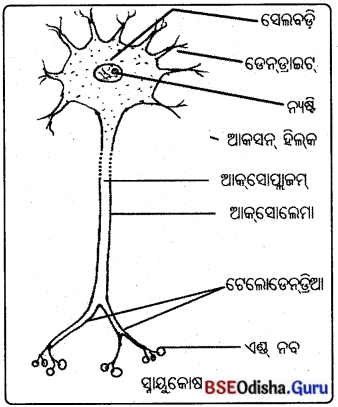
9. ମସ୍ତିଷ୍କର ନାମାଙ୍କିତ ଚିତ୍ର ଅଙ୍କନ କର ।
ଊ-
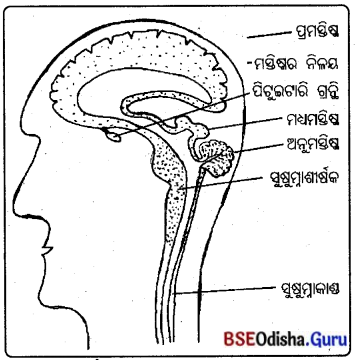
10. ସିନାପସ୍ର ନାମାଙ୍କିତ ଚିତ୍ର ଅଙ୍କନ କର ।
ଊ-
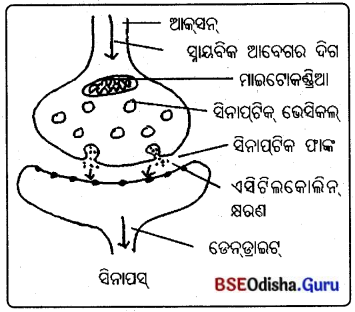
![]()
11. ପ୍ରତିକ୍ଷେପକ୍ରିୟାର ନାମାଙ୍କିତ ଚିତ୍ର ଅଙ୍କନ କର ।
ଊ-
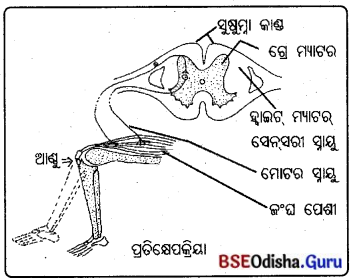
12. ମାନବ ଶରୀରରେ ଅନ୍ତଃସ୍ରାବୀ ତନ୍ତ୍ରର ନାମାଙ୍କିତ ଚିତ୍ର ଅଙ୍କନ କର ।
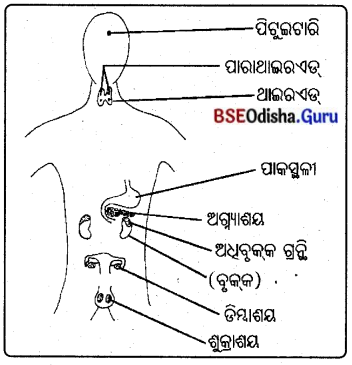
![]()
1. ପ୍ରାଣୀ ଓ ଉଦ୍ଭଦ ଶରୀରରେ ନିୟନ୍ତ୍ରଣ ଓ ସମନ୍ୱୟ କିପରି ହୋଇଥାଏ ?
ଊ-
- ଉଦ୍ଭଦରେ ରାସାୟନିକ ପଦ୍ଧତିରେ ନିୟନ୍ତ୍ରଣ ଓ ସମନ୍ବୟ ହୋଇଥାଏ ।
- ପ୍ରାଣୀ ଶରୀରରେ ସ୍ନାୟବିକ ଉଭୟ ପଦ୍ଧତିରେ ନିୟନ୍ତ୍ରଣ ଓ ସମନ୍ଵୟ ହୋଇଥାଏ ।
2. ପ୍ରତିକୂଳ ଓ ଅନୁକୂଳ ଆଲୋକାନୁବର୍ତ୍ତନ କ’ଣ ଲେଖ ।
ଉ-
- ଆଲୋକାନୁବର୍ତ୍ତନ ଉଭିଦମାନଙ୍କର ଏକ ବିଶେଷ ଲକ୍ଷଣ । ଉଭିଦର କାଣ୍ଡ ଆଲୋକ ଆଡ଼କୁ ଗତି କରିଥାଏ । ଏହାକୁ ଅନୁକୂଳ ଆଲୋକାନୁବର୍ତ୍ତନ କହନ୍ତି ।
- ଉଭିଦର ଚେର ଆଲୋକର ବିପରୀତ ଦିଗକୁ ଉଭିଦର ଚେର ଆଲୋକର ବିପରୀତ ଦିଗକୁ କୁହାଯାଏ ।
3. ଫ୍ଲୋରିଜେନ୍ ଓ ଫାଇଟୋକ୍ରୋମ ହରମୋନର କାର୍ଯ୍ୟ କ’ଣ ?
ଉ-
- ଫ୍ଲୋରିଜେନ୍ ଏକ ହରମୋନ୍ ଯାହା ଉଦ୍ଭଦର ଅଗ୍ରଭାଗକୁ ପ୍ରବାହିତ ହୋଇ ଫୁଲ ଧରିବା ପ୍ରକ୍ରିୟାରେ ସାହାଯ୍ୟ କରେ ।
- ଉଦ୍ଭଦରେ ଫାଇଟୋକ୍ରୋମ୍ ନାମକ ଏକ ସ୍ଵତନ୍ତ୍ର ବର୍ଷ କଣା ହରମୋନ ସହିତ ରହିଥାଏ । ଫ୍ଲୋରିଜେନ୍ ଓ ଫାଇଟୋକ୍ରୋମ ଉଦ୍ଭଦରେ ଫୁଲ ଧରିବା ପ୍ରକ୍ରିୟା ନିୟନ୍ତ୍ରଣ କରେ ।
4. ମଧ୍ୟମସ୍ତିଷ୍କର ଦୁଇଯୋଡ଼ା ବର୍ତ୍ତୁଳ ନିଦାପିଣ୍ଡର କାର୍ଯ୍ୟ କ’ଣ ?
ଊ-
- ମଧ୍ୟମସ୍ତିଷ୍କରେ ଥିବା ଦୁଇଯୋଡ଼ା ପିଣ୍ଡ ମଧ୍ୟରୁ ଉପର ଦୁଇଟି ପିଣ୍ଡ ଦୃଷ୍ଟି ସମ୍ବନ୍ଧୀୟ ପ୍ରତିକ୍ଷେପକୁ ନିୟନ୍ତ୍ରଣ କରିଥାଏ ।
- ନିମ୍ନଭାଗରେ ଥିବା ଦୁଇଟି ପିଣ୍ଡ ଶ୍ରବଣ ସମ୍ବନ୍ଧୀୟ ପ୍ରତିକ୍ଷେପକୁ ନିୟନ୍ତ୍ରଣ କରିଥାନ୍ତି ।
5. ଉଦ୍ଭଦର କାଣ୍ଡର ବୃଦ୍ଧି ଉପରେ ହରମୋନ୍ ର ପ୍ରଭାବ କ’ଣ ଲେଖ ।
ଉ-
- ଗୋଟିଏ ଗଛକୁ ସମାନ୍ତର ଭାବରେ ରଖୁଲେ ହରମୋନ୍ର ସାନ୍ଦ୍ରତା କାଣ୍ଡର ନିମ୍ନ ଅଂଶରେ ବୃଦ୍ଧିପାଏ ଏବଂ ଏଠାରେ ବୃଦ୍ଧି ଅଧିକ ହୁଏ ।
- କାଣ୍ଡର ଊର୍ଦ୍ଧ୍ବଭାଗରେ ହରମୋନ୍ର ସାନ୍ଦ୍ରତା କମ୍ ହେବାରୁ ସେଠାରେ ବୃଦ୍ଧି କମ୍ ହୁଏ । କାଣ୍ଡ ବୃଦ୍ଧିରେ ଏହି ଅସମାନତା ଯୋଗୁଁ କାଣ୍ଡଟି ଊର୍ଦ୍ଧ୍ୱଗାମୀ ହୋଇଥାଏ ।
6. ମୂଳର ବୃଦ୍ଧି ଉପରେ ହରମୋନ୍ର ପ୍ରଭାବ କ’ଣ ଲେଖ ।
ଊ-
- ମୂଳର ଯେଉଁ ଅଂଶରେ ହରମୋନ୍ର ସାନ୍ଦ୍ରତା କମ୍ ସେଠାରେ ବୃଦ୍ଧି ଅଧିକ ହୁଏ ଏବଂ ଯେଉଁଠାରେ ଗତିକରେ ଅର୍ଥାତ୍ ଆଲୋକଠାରୁ ଦୂରରେ ହ୍ରାସ ପାଏ ।
- ଫଳରେ ମୂଳର ବୃଦ୍ଧି କାଣ୍ଡ ବୃଦ୍ଧିର ବିପରୀତ ଦିଗରେ ହୋଇଥାଏ ଏବଂ ମୂଳ ଭୂପୃଷ୍ଠ ଆଡ଼କୁ ବଙ୍କେଇ ଯାଇଥାଏ ।
![]()
7. ସୁଷୁମ୍ନାଶୀର୍ଷକର ଅବସ୍ଥିତି ଓ କାର୍ଯ୍ୟ ଲେଖ ।
ଊ-
- ଏହା ଅନୁ ମସ୍ତିଷ୍କ ପଛକୁ ରହିଥାଏ । ଆମ ଶରୀରର ଶ୍ଵାସକେନ୍ଦ୍ର ଓ ହୃତ୍କେନ୍ଦ୍ର ।
- ଏହା ରକ୍ତଚାପ, ଛିଙ୍କ, ବାନ୍ତି, କାଶ, ଖାଦ୍ୟ ଗିଳିବା ପରି କାର୍ଯ୍ୟକୁ ନିୟନ୍ତ୍ରଣ କରେ ।
8. ସୁଷୁମ୍ନାକାଣ୍ଡର ଦୁଇଟି କାର୍ଯ୍ୟ ଲେଖ ।
ଊ-
- ଏହା ମଧ୍ୟଦେଇ ଶରୀରର ବିଭିନ୍ନ ଅଂଶରୁ ସଂଗୃହୀତ ବାର୍ତ୍ତା ମସ୍ତିଷ୍କକୁ ଯାଏ ଏବଂ ମସ୍ତିଷ୍କରୁ ପ୍ରେରିତ ଆଦେଶ ଶରୀରର ବିଭିନ୍ନ କାର୍ଯ୍ୟକାରୀ ଅଙ୍ଗ ନିକଟରେ ପହଞ୍ଚେ ।
- ଏହା ମସ୍ତିଷ୍କ ବିନା ନିର୍ଦ୍ଦେଶରେ ହେଉଥିବା କାର୍ଯ୍ୟ ବା ପ୍ରତିକ୍ଷେପ କ୍ରିୟା କରିଥାଏ ।
9. ଡାଇବେଟିସ୍ ଇନ୍ ସିପିଡସ୍ ଓ ଡାଇବେଟିସ୍ ମେଲିଟସ୍ କହିଲେ କ’ଣ ବୁଝ ?
ଉ-
- ଯଦି କୌଣସି କାରଣବଶତଃ ପିଟୁଇଟାରିରୁ ଅଳ୍ପ ପରିମାଣର ଭାସୋପ୍ରେସିନ୍ କ୍ଷରିତ ହୁଏ, ତେବେ ସେହି ବ୍ୟକ୍ତି ଗୋଟିଏ ଦିନରେ ପାଖାପାଖ୍ 20 ଲିଟର ପର୍ଯ୍ୟନ୍ତ ପରିସ୍ରା କରେ । ଏହି ଅବସ୍ଥାକୁ ଡାଇବେଟିସ୍ ଇନ୍ସିପିଡସ୍ ବା ବହୁମୂତ୍ର ରୋଗ କୁହାଯାଏ ।
- ଇନ୍ ସୁଲିନ୍ ର ଅଭାବରେ ରକ୍ତରେ ଶର୍କରା ପରିମାଣ ବଢ଼ିଗଲେ ଡାଇବେଟିସ୍ ମେଲିଟସ୍ ବା ମଧୁମେହ ରୋଗ ହୋଇଥାଏ ।
10. ଅକ୍ସିର କାର୍ଯ୍ୟ ଉଲ୍ଲେଖ କର ।
ଊ-
- ଏହି ହରମୋନ୍ ଜୀବକୋଷର ବୃଦ୍ଧି, ଫୁଲ ଓ ଫଳର ଗଠନ ଆଦି ବିଭିନ୍ନ ପ୍ରକ୍ରିୟାକୁ ପ୍ରଭାବିତ କରିଥାଏ ।
- ଏହା ଉଦ୍ଭଦର ବୃଦ୍ଧି ନିୟନ୍ତ୍ରଣ କରେ ।
- ଏହି ହରମୋନ୍ ଉଦ୍ଭିଦର ଶାଖା ଓ କାଣ୍ଡର ବୃଦ୍ଧିରେ ସହାୟକ ହୋଇଥାଏ ।
11. ଏଡ୍ରି ନାଲ୍ କୁ ଆପଦକାଳୀନ ଗ୍ରନ୍ଥି କୁହାଯାଏ କାହିଁକି ?
ଊ-
- ଏଡ୍ରିନାଲ ଗ୍ରନ୍ଥିରୁ ଅନେକଗୁଡ଼ିଏ ହର୍ ମୋନ୍ କ୍ଷରିତ ହୁଏ ଓ ସେଥୁମଧ୍ୟରୁ ଏଡ୍ରି ନାଲି ନ୍ ହରମୋନ ଅନ୍ୟତମ ଅଟେ ।
- ଏହି ହରମୋନ୍ ଆକସ୍ମିକ ଆଘାତ, ଭୟ, ଅବଶ ଓ ଉତ୍ତେଜିତ ଅବସ୍ଥାରେ କ୍ଷରିତ ହୁଏ ।
- ଉପରୋକ୍ତ କାର୍ଯ୍ୟମାନଙ୍କ ଯୋଗୁ ଏହି ଗ୍ରନ୍ଥିକୁ ‘ଆପଦକାଳୀନ ଗ୍ରନ୍ଥି’ କୁହାଯାଏ ।
12. ଲାଜକୁଳୀ ଲତାରେ କି ପ୍ରକାର ଗତି ଦେଖାଯାଏ ?
ଉ-
- ଲାଜକୁଳୀ ଲତାର ଡାଳ କିମ୍ବା ପତ୍ରକୁ ଛୁଇଁଦେବା ମାତ୍ରେ ଲତାରେ ଥି ପତ୍ରଗୁଡ଼ିକ ନଇଁଯାଇ ଝାଉଁଳି ପଡ଼େ ।
- ସ୍ପର୍ଶ ପ୍ରତି ଅନୁକ୍ରିୟା ପ୍ରଦର୍ଶନ ସ୍ୱରୂପ ପତ୍ରଗୁଡ଼ିକ ଜାକି ହୋଇଯା’ନ୍ତି ।
- ଲାଜକୁଳୀ ଲତାର ଏହି ଗତିକୁ ଅନ୍ତକୁଞ୍ଚନ ଗତି କୁହାଯାଏ ।
- ଏହା ସ୍ପର୍ଶଜନିତ ଉଦ୍ଦୀପନାର ଏକ ବିଶେଷ ଉଦାହରଣ ଅଟେ ।
13. ମସ୍ତିଷ୍କର ବିଭିନ୍ନ ଅଂଶର ନାମ ଲେଖ ।
(i) ମସ୍ତିଷ୍କ ତିନି ଭାଗରେ ବିଭକ୍ତ, ଯଥା-
- ଅଗ୍ର ମସ୍ତିଷ୍କ,
- ମଧ୍ୟମସ୍ତିଷ୍କ ଓ
- ପଶ୍ଚିମସ୍ତିଷ୍କ ।
(ii) ଅଗ୍ରମସ୍ତିଷ୍କରେ
- ଘ୍ରାଣପାଳି
- ପ୍ରମସ୍ତିଷ୍କ ଓ
- ପଶ୍ଚଅଗ୍ରମସ୍ତିଷ୍କ ରହିଥାଏ ।
![]()
(iii) ମଧ୍ୟମସ୍ତିଷ୍କ 4ଗୋଟି ବର୍ତ୍ତୁଳ ପିଣ୍ଡଚତୁଷ୍କକୁ ନେଇ ଗଠିତ ।
(iv) ପଶ୍ଚ ମସ୍ତିଷ୍କରେ
- ଅନୁ ମସ୍ତିଷ୍କ ଓ
- ସୁଷୁମ୍ନାଶୀର୍ଷକ ରହିଥାଏ ।
14. ହାଇପୋଥାଲାମସ୍ ଗ୍ରନ୍ଥିର ଅବସ୍ଥାନ ଓ ଏଥିରୁ କ୍ଷରିତ ହରମୋନର ନାମ ଓ କାର୍ଯ୍ୟ ଲେଖ ।
- ଅଗ୍ରମସ୍ତିଷ୍କରେ ଥିବା ଥାଲାମସ୍ର ନିମ୍ନଭାଗରେ ଏବଂ ପି ଟୁ ଇଟାରି ଗ୍ରନ୍ଥି ର ଉପର କୁ ହାଇପୋଥାଲାମସ୍ ଅବସ୍ଥିତ ।
- ହାଇପୋଥୋଲାମସ୍ତୁରୁ କେତେକ ରିଲିଜିଙ୍ଗ୍ ହର୍ମୋନ୍ ଏବଂ ଇନ୍ହିବିଟିଙ୍ଗ୍ ହର୍ମୋନ୍ କ୍ଷରିତ ହୁଏ ।
- ଏହି ହରମୋନ୍ଗୁଡ଼ିକ ପିଟୁଇଟାରି ଗ୍ରନ୍ଥିର କ୍ଷରଣ କ୍ଷମତାକୁ ନିୟନ୍ତ୍ରଣ କରନ୍ତି ।
15. ପିଟୁଇଟାରି ଗ୍ରନ୍ଥିର ଅବସ୍ଥାନ ଓ ଏଥିରୁ କ୍ଷରିତ ହରମୋନର ନାମ ଲେଖ ।
ଉ-
ପିଟୁଇଟାରି ଗ୍ରନ୍ଥି ହାଇପୋଥାଲାମସ୍ ସହିତ ଏକ ଛୋଟ ବୃନ୍ତ ସାହାଯ୍ୟରେ ଲାଗିରହିଥାଏ । ଏହି ଗ୍ରନ୍ଥି ଦୁଇଟି ପୃଥକ୍ ଖଣ୍ଡକୁ ନେଇ ଗଠିତ, ଯଥା
- ଏ ଡ ନି । ହ । ଇ. ପ। ଫ । ଇ ସଁ ସ (Adenohypophysis) img ହରମୋନ୍ – GH, PRL, FSH, LH, TSH, ACTH]
- ନ ଉ ର । ହ । ଇ ପ। ଫ । ଇ ସଁ ସ, (Neurohypophysis) img ହରମୋନ୍ – ଅକ୍ସିଟୋସିନ୍, ଭାସୋପ୍ରେସିନ୍]
16. ପିନିଆଲ ଗ୍ରନ୍ଥିର ଅବସ୍ଥାନ ଓ ଏଥିରୁ କ୍ଷରିତ ହରମୋନର ନାମ ଓ କାର୍ଯ୍ୟ ସମ୍ବନ୍ଧରେ ଲେଖ ।
ଉ-
- ପିନିଆଲ୍ ଗ୍ରନ୍ଥି ଅଗ୍ରମସ୍ତିଷ୍କର ଛାତରେ ରହିଥାଏ ।
- ଏହା ଆକାରରେ ଅତ୍ୟନ୍ତ ଛୋଟ ଓ ଓଜନ ମାତ୍ର 150 ମିଲିଗ୍ରାମ୍ ଅଟେ ।
- ଏଥୁରୁ ମେଲାଟୋନିନ୍ ନାମକ ହର୍ମୋନ୍ କ୍ଷରିତ ହୁଏ ।
- ଏହାର ପ୍ରଭାବ ଡିମ୍ବୋତ୍ସର୍ଗ ଓ ନିଦ୍ରା ଉପରେ ପଡ଼ିଥାଏ । ଏହା ଶରୀରର ‘ଜୈବିକ ଘଡ଼ି’ ଭାବେ ମଧ୍ୟ କାର୍ଯ୍ୟକରେ ।
17. ଥାଇରାଏଡ଼ ଗ୍ରନ୍ଥିର ଅବସ୍ଥାନ ଓ ଏଥୁରୁ କ୍ଷରିତ ହରମୋନ୍ର ନାମ ଓ କାର୍ଯ୍ୟ ସମ୍ବନ୍ଧରେ ଲେଖ ।
ଉ-
- ଥାଇରଏଡ୍ ଗ୍ରନ୍ଥି ବେକର ତଳ ଭାଗରେ, ଶ୍ଵାସନଳୀର ଉଭୟ ପଟରେ ଠିକ୍ ସ୍ୱରପେଟିକାର ପଛକୁ ରହିଥାଏ ।
- ଏଥିରୁ ମୁଖ୍ୟତଃ ଥାଇରକ୍ସିନ୍ ହର୍ମୋନ୍ କ୍ଷରିତ ହୁଏ ।
- ଏହା ଶରୀରର ବିଭିନ୍ନ କୋଷର ଅମ୍ଳଜାନ ଶରୀରରେ ଅଧିକ ଶକ୍ତି ସୃଷ୍ଟି ହୁଏ । ଏହା ସାହାଯ୍ୟ କରେ ।
18. ଶୁକ୍ରାଶୟ ଗ୍ରନ୍ଥିର ଅବସ୍ଥାନ ଓ ଏଥୁରୁ କ୍ଷରିତ ହରମୋନ୍ର ନାମ ଓ କାର୍ଯ୍ୟ ସମ୍ବନ୍ଧରେ ଲେଖ ।
ଊ-
- ଆମ ଶରୀରର ଶୁକ୍ରାଶୟ ଥଳି ମଧ୍ୟରେ ଦୁଇଟି ଶୁକ୍ରାଶୟ ରହିଥାଏ ।
- ଶୁକ୍ରାଶୟ ମଧ୍ୟରେ ଥିବା ଲେଡ଼ିଗ୍ କୋଷରୁ କ୍ଷରିତ ହୁଏ ।
- ଯୁବକ୍ରାନ୍ତି ସମୟରେ ଟେଷ୍ଟୋଷ୍ଟିରନ୍ର ପ୍ରଭାବରେ ଲକ୍ଷଣମାନ ଦେଖାଯାଏ ।
- ଟେଷ୍ଟୋଷ୍ଟିରନ୍ ଶୁକ୍ରାଣୁ ଉତ୍ପତ୍ତିରେ ମଧ୍ୟ ସହାୟକ ଦେଖାଯାଏ ।
19. ଡିମ୍ବାଶୟ ଗ୍ରନ୍ଥିର ଅବସ୍ଥାନ ଓ ଏଥିରୁ କ୍ଷରିତ ହରମୋନର ନାମ ଓ କାର୍ଯ୍ୟ ସମ୍ବନ୍ଧରେ ଲେଖ ।
ଊ-
ସ୍ତ୍ରୀ ଶରୀର ଉଦର ଗହ୍ଵରର ନିମ୍ନ ଅଂଶରେ ଏକ ଯୋଡ଼ା ଡିମ୍ବାଶୟ ରହିଥାଏ ।
- ଡିମ୍ବାଶୟରୁ ଇଷ୍ଟୋଜେନ୍ ଓ ପ୍ରୋଜେଷ୍ଟିରନ୍ ହର୍ମୋନ୍ କ୍ଷରିତ ହୁଏ ।
- ଇଷ୍ଟ୍ରୋଜେନ୍ ହର୍ ମୋନ୍ ର ପ୍ରଭାବରେ ବାଳିକାମାନଙ୍କ ଶରୀରରେ ସ୍ତ୍ରୀ-ଗୌଣ ଲିଙ୍ଗୀୟ ଲକ୍ଷଣମାନ ଦେଖାଯାଏ ।
- ପ୍ରୋଜେଷ୍ଟିରନ୍ ହର୍ମୋନ୍ ଡିମ୍ବୋଦୟ ପରେ ଡିମ୍ବାଶୟରୁ କ୍ଷରିତ ହୁଏ ।
- ଗର୍ଭଧାରଣରେ ଏହାର ଗୁରୁତ୍ବପୂର୍ଣ୍ଣ ଭୂମିକା ଥିବାରୁ ଏହାକୁ ‘‘ଗର୍ଭାବସ୍ଥାର ହର୍ମୋନ୍’’ କୁହାଯାଏ ।
![]()
20. ଫାଇଟୋହର୍ମୋନ୍ ହରମୋନ୍ କହିଲେ କ’ଣ ବୁଝ ?
ଉ-
- ଉଦ୍ଭିଦରେ ଥିବା ହର୍ ମୋନ କୁ ଫାଇଟୋହର୍ମୋନ୍ କୁହାଯାଏ ।
- ଏହା ମୁଖ୍ୟତଃ ପାଞ୍ଚ ପ୍ରକାରର ; ଯଥା- ଜି ବରେଲିନ୍, ସାଇଟୋକାଇନିନ୍, ଏଥ୍ଲିନ୍ ଏବଂ ଅବ୍ସିକ୍ ଏସିଡ୍ ।
21. ଫଟୋପିରିୟଡିଜିମ୍ କ’ଣ ସଂକ୍ଷେପରେ ବୁଝାଅ ।
ଉ-
- ଉଭିଦର ଫୁଲ ଧରିବା ପ୍ରକ୍ରିୟା ଆଲୋକର ଅବଧୂ ଉପରେ ନିର୍ଭର କରେ । ଏହାକୁ
- ଅନୁ ଧ୍ୟାନ ରୁ ଜଣାଯାଇଛି ଯେ ଉଭିଦ ଆଲୋକାବଧୂ ପାଏ, ସେତେବେଳେ ତା’ର ସହାୟକ ହର୍ମୋନ୍ ତିଆରି ହୁଏ ।
22. ଫାଇଟୋକ୍ରୋମ୍ର ସଂକ୍ଷିପ୍ତ ବିବରଣୀ ଦିଅ ।
ଉ-
- ହର୍ ମୋନ୍ ସହି ତ ଫାଇଟୋକ୍ରୋମ୍ ନାମକ ଏକ ସ୍ଵତନ୍ତ୍ର ବର୍ଷକଣା ରହିଥାଏ ।
- ଫ୍ଲୋରି ଜେନ୍ ଓ ଫାଇଟୋକ୍ରୋମ୍ ଉଭିଦର ଫୁ ଲ ଧରି ବା। ପ୍ରକ୍ରିୟାକୁ ନିୟନ୍ତ୍ରଣ କରିଥା’ନ୍ତି ।
![]()
23. ବୃଦ୍ଧି ନିୟନ୍ତ୍ରକ ହରମୋନ୍ କହିଲେ କ’ଣ ବୁଝ ?
ଉ-
- ଫାଇଟୋହର୍ ମୋନ୍ ମଧ୍ୟରୁ ଅକ୍ସିନ୍, ଜିବରେଲିନ୍ ଓ ସାଇଟୋକାଇନିନ୍ ପ୍ରଭୃତି ବୃଦ୍ଧି ନିୟନ୍ତ୍ରଣ କରିଥା’ନ୍ତି ।
- ଜିବରେଲିନ୍, ଅକ୍ସିନ୍ ପରି ଶାଖା ଓ କାଣ୍ଡର
- ଅନ୍ୟପକ୍ଷରେ ସାଇଟୋକାଇନିନ୍ କୋଷ ବିଭାଜନର ହାର ବୃଦ୍ଧି କରିଥାଏ ଓ ଏହି ହରମୋନ୍ ସାଧାରଣତଃ କ୍ଷି ପ୍ରଭାବେ – ଅଧିକ ପରିମାଣରେ ଉପଲବ୍ଧ ହୁଏ ।
24. ବୃଦ୍ଧିହ୍ରାସକ ହରମୋନ୍ କାହାକୁ କହନ୍ତି ?
ଉ-
- ଉଭିଦର ବୃଦ୍ଧି ନିୟନ୍ତ୍ରଣ ବା ବୃଦ୍ଧିରୋଧ ପାଇଁ ଏକ ସଙ୍କେତ ଆବଶ୍ୟକ ।
- କେତେକ ଫାଇଟୋହର୍ ମୋନ୍ ଉଦ୍ଭଦର ହରମୋନ୍ ରହିଥା’ନ୍ତି ।
- ଆକ୍ସିସିକ୍ ଅମ୍ଳ ଓ ଏଥ୍ନ୍ ଏହାର ଉଦାହରଣ ଅଟନ୍ତି ।


